Digi XBEEXSC XBee-PRO XSC RF Module User Manual manual xs oem rf module v42b5
Digi International Inc XBee-PRO XSC RF Module manual xs oem rf module v42b5
Digi >
Contents
- 1. User Manual
- 2. Antenna List
User Manual
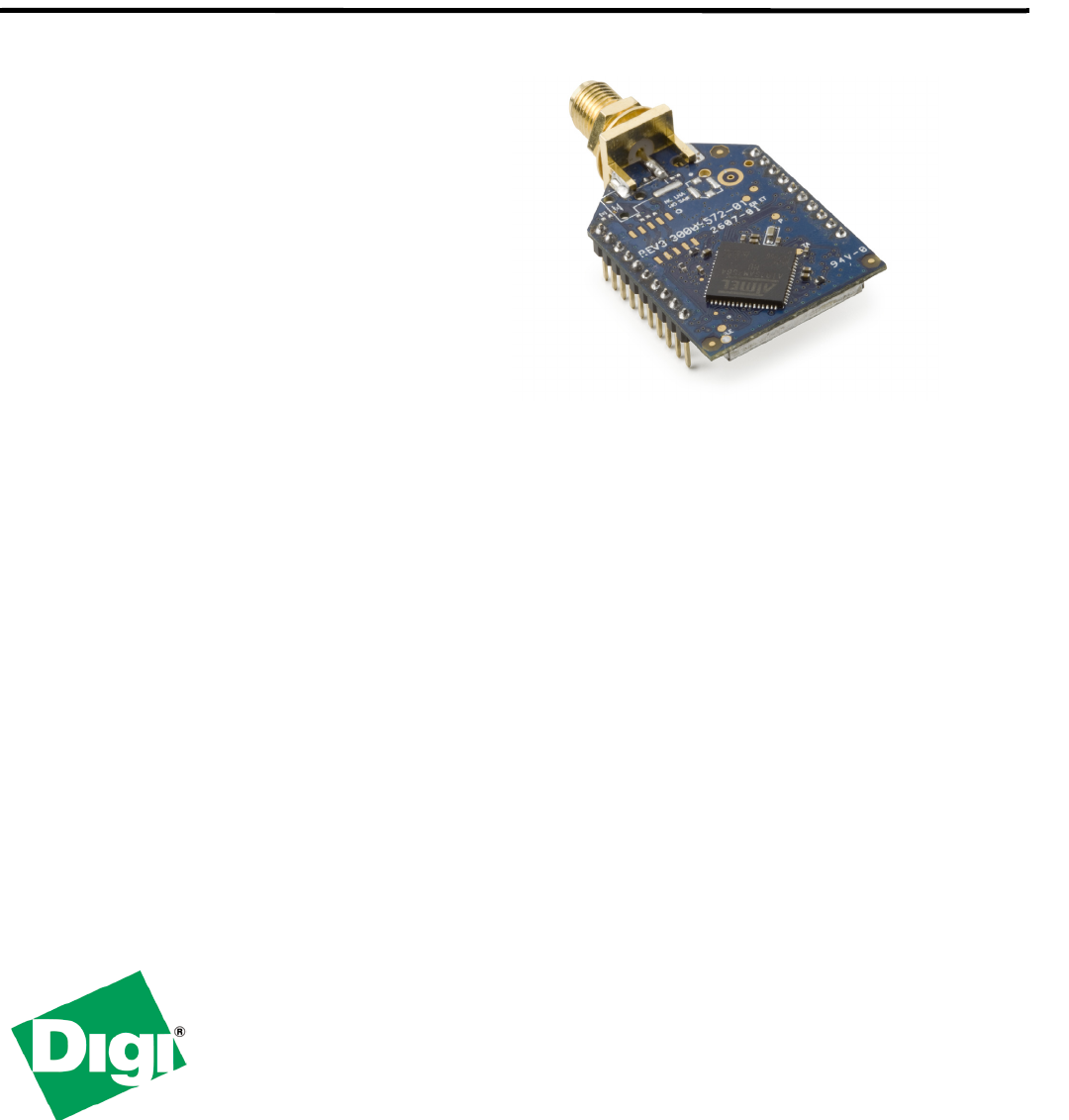
11001 Bren Road East
Minnetonka, MN 55343
www.digi.com
Preliminary Draft
XBee-PRO™ XSC RF Module
XBee-PRO XSC RF Module
RF Module Operation
RF Module Configuration
Appendices
Product Manual 90000938-A
For RF Module Part Number:
XBP09-XC…
900 MHz OEM RF Modules by Digi International Inc.

XBee‐PRO™XSCRFModule‐ProductManual90000938‐A[2008.2.25]
©2008DigiInternational,Inc. ii
© 2008 Digi International, Inc. All rights reserved
Nopartofthecontentsofthismanualmaybetransmittedorreproducedinany
formorbyanymeanswithoutthewrittenpermissionofDigiInternational,Inc.
XBee‐PRO™isaregisteredtrademarkofDigiInternationalInc.
TechnicalSupport:Phone:(801)765‐9885
LiveChat:www.digi.com
E‐mail:support@digi.com

Contents
XBee‐PRO™XSCOEMRFModules‐ZigBee‐v4.2B5PreliminaryDraft
©2008DigiInternaitonal,Inc. 1
1. XBee-PRO™ XSC OEM RF Module.......... 4
Key Features......................................... 5
Worldwide Acceptance .......................... 5
Specifications ....................................... 6
Pin Signals............................................ 7
Electrical Characteristics ...................... 8
Timing Specifications ............................ 8
Mechanical Drawings ............................ 9
2.RF Module Operation .......................... 10
Serial Communications ....................... 10
UART-Interfaced Data Flow.................. 10
Serial Data ........................................ 10
Flow Control ...................................... 11
Modes of Operation ............................ 12
Idle Mode .......................................... 12
Transmit Mode................................... 12
Receive Mode .................................... 14
Sleep Mode ....................................... 14
Command Mode ................................. 17
3.RF Module Configuration..................... 19
Programming Examples ...................... 19
AT Commands ................................... 19
Binary Commands .............................. 19
Command Reference Table ................. 20
Command Descriptions ...................... 21
Agency Certifications 33
FCC (United States) Certification ........ 33
Labeling Requirements ........................ 33
FCC Notices ....................................... 33
Limited Modular Approval .................... 33
FCC-approved Antennas ...................... 34
IC (Industry Canada) Certification ..... 34
Additional Information ........................... 38
5-Year Warranty ................................. 38
Ordering Information ......................... 38
Contact Digi ........................................ 40
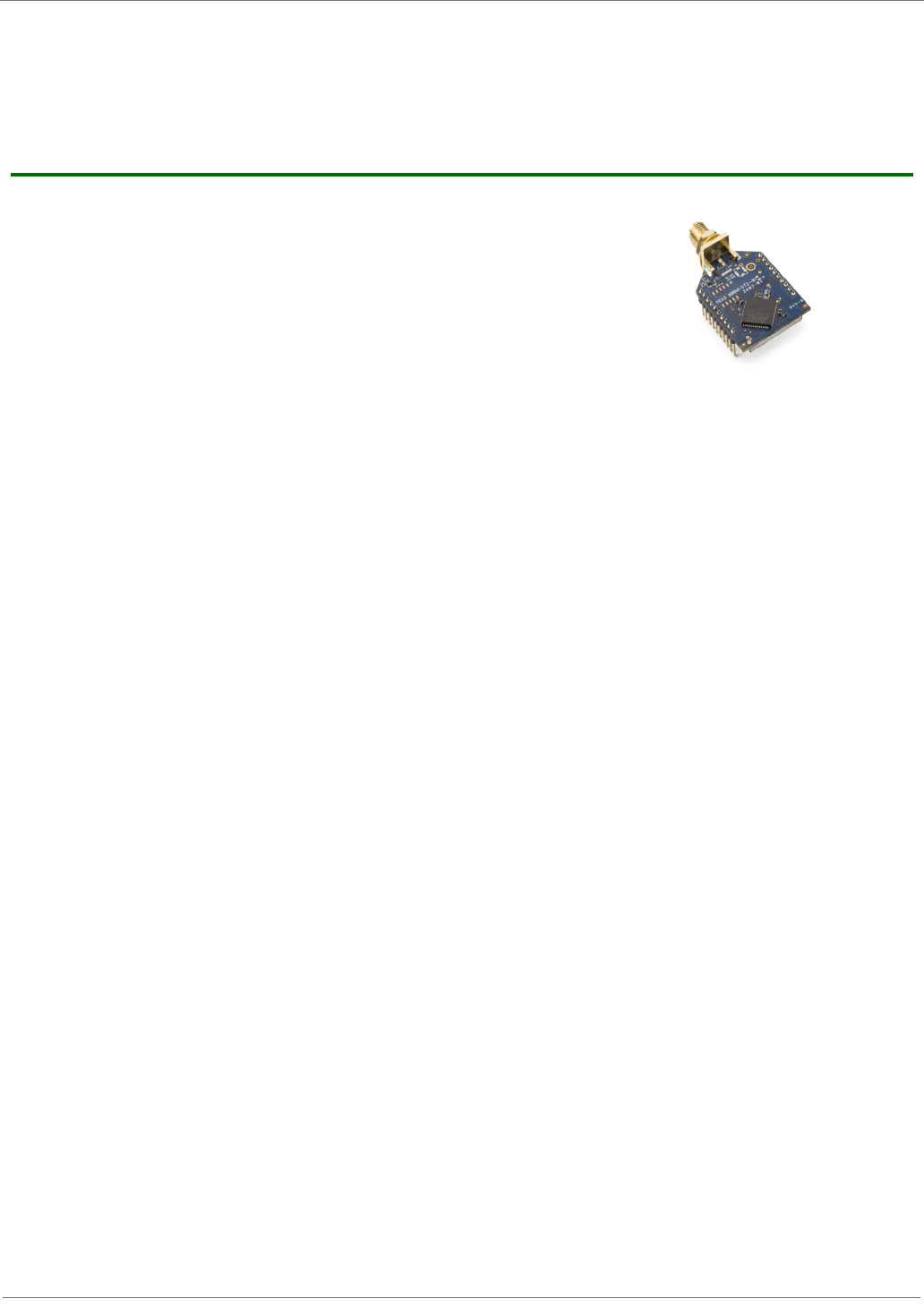
XBee‐PRO™XSCOEMRFModules
©2008DigiInternational,Inc. 4
PreliminaryDraft
1.XBee‐PRO™XSCOEMRFModule
The XBee-PRO XSC (900 MHz) OEM RF Modules were
engineered to afford OEMs and integrators an easy-to-use RF
solution that provides reliable delivery of critical data between
remote devices. These modules come configured to sustain
reliable long range wireless links.
The XBee-PRO Module is a drop-in wireless solution that
transfers a standard asynchronous serial data stream.
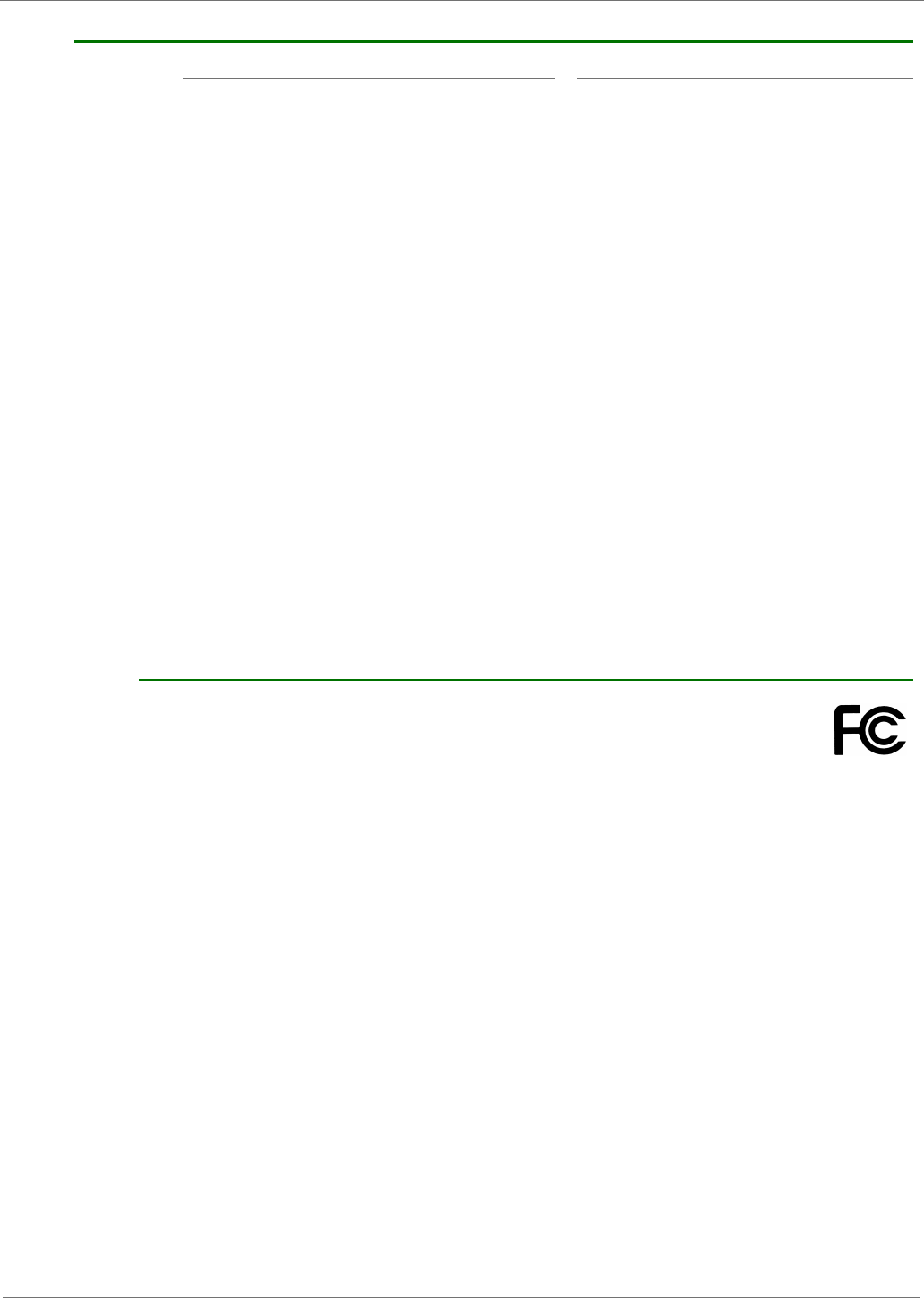
XBee‐PRO™XSCOEMRFModules
©2008DigiInternational,Inc. 5
PreliminaryDraft
1.1. Key Features
1.1.1. Worldwide Acceptance
FCC Certified (USA) - Refer to Appe ndix A for FCC Requir e ments.
Systems that include XBee-PRO Modules inherit Digi’s FCC Certification
ISM (Industrial, Scientific & Medical) frequency band
Manufactured under ISO 9001:2000 registered standards
XBee-PRO™ XSC (900 MHz) OEM RF Modules are approved for use in US and
Canada.
Long Range Data Integrity
XBee-PRO XSC (900 MHz) Range:
• Indoor/Urban: up to 1200' (370m)
• Outdoor line-of-sight: up to 6 miles (9.6 km)
w/ 2.1 dBm dipole antenna
• Outdoor line-of-sight: up to 15 miles (24
km) w/ high gain antenna
• Receiver Sensitivity: -106 dBm (900 MHz),
Advanced Networking & Security
• True peer-to-peer (no "master" required)
communications
• Point-to-point & point-to-multipoint topolo-
gies supported
• Retries and Acknowledgements
• 7 hopping channels, each with over 65,000
available network addresses
• FHSS (Frequency Hopping Spread Spec-
trum)
• Input pins are 5 volt tolerant
Easy-to-Use
• Continuous RF data stream
up to 9600 bps
• No configuration required for out-of-box
RF data communications
• Advanced configurations available throu
standard AT & binary Commands
• Portable (small form factor easily design
into a wide range of data radio systems
• Software-selectable serial interfacing ra
• MODBUS, CTS, RTS, DTR, DCD (& more
I/O Support
• Support for multiple data formats
(parity, start and stop bits, etc.)
• XII™ Interference Immunity
• Power-saving Sleep Modes
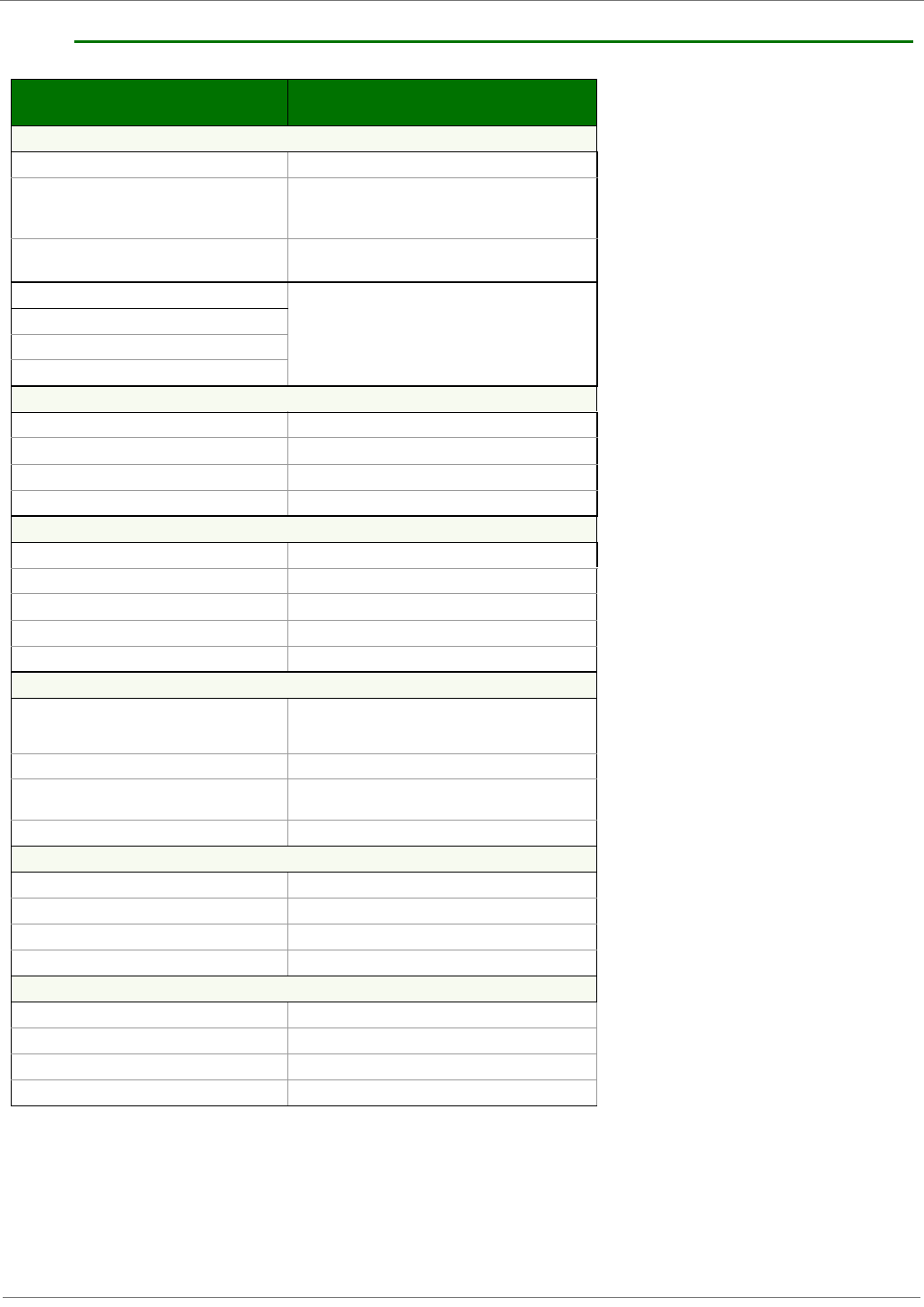
XBee‐PRO™XSCOEMRFModules
©2008DigiInternational,Inc. 6
PreliminaryDraft
1.2. Specifications
Table1‐01. XBee‐PROXSCOEMRFModuleSpecifications
Specification XBee-PRO XSC (900 MHz)
OEM RF Module
Performance
Indoor/Urban Range up to 1200ft (370m)
Outdoor line-of-sight Range
Up to 6 miles (9.6km) w/ dipole antenna
Up to 15 miles (24 km) w/ high-gain antenna
Interface Data Rate 125 - 65,000 bps
(Software selectable, includes non-standard baud rates)
Throughput Data Rate 9,600 bps
10 kbps
100 mW (+20 dBm)
-106dBm
RF Data Rate
Transmit Power Output
Receiver Sensitivity
Power Requirements
Supply Voltage 3.0-3.6 VDC regulated
Receive Current 65mA
Transmit Current 265mA
Power Down Current 50 µA
General
Frequency Range 902.7-927.3 MHz
Spread Spectrum Frequency Hopping, Wide band FM modulator
Network Topology Point-to-Point, Peer-to-Peer, Point-to-Multipoint
Channel Capacity 7 hop sequences share 25 frequencies
Board-level Serial Data Interface CMOS UART
Physical Properties
Module Board Size
1.297" x 0.962" x 0.215 (3.29 cm x 2.44 cm x 0.546 cm)
Note: Dimensions do not include connector/antenna or
pin lengths
Weight 5 to 8 grams, depending on the connector/antenna
Connector 2 rows of 10 pins, 22mm apart with 2mm spaced male
Berg-type headers
Operating Temperature -40 to 85º C (industrial)
Antenna Options
Integrated Wire ¼ wave monopole, 3.25” (8.26 cm) length, 1.9 dBi Gain
Integrated Helical 0.315" (0.8 cm) height
Connector Reverse-polarity SMA or U.FL
Impedance 50 ohms unbalanced
Certifications )
FCC Part 15.247 MXQ-XBEEXSC
Industry Canada (IC) 1846A-XBEEXSC
Europe N/A
RoHS Compliant
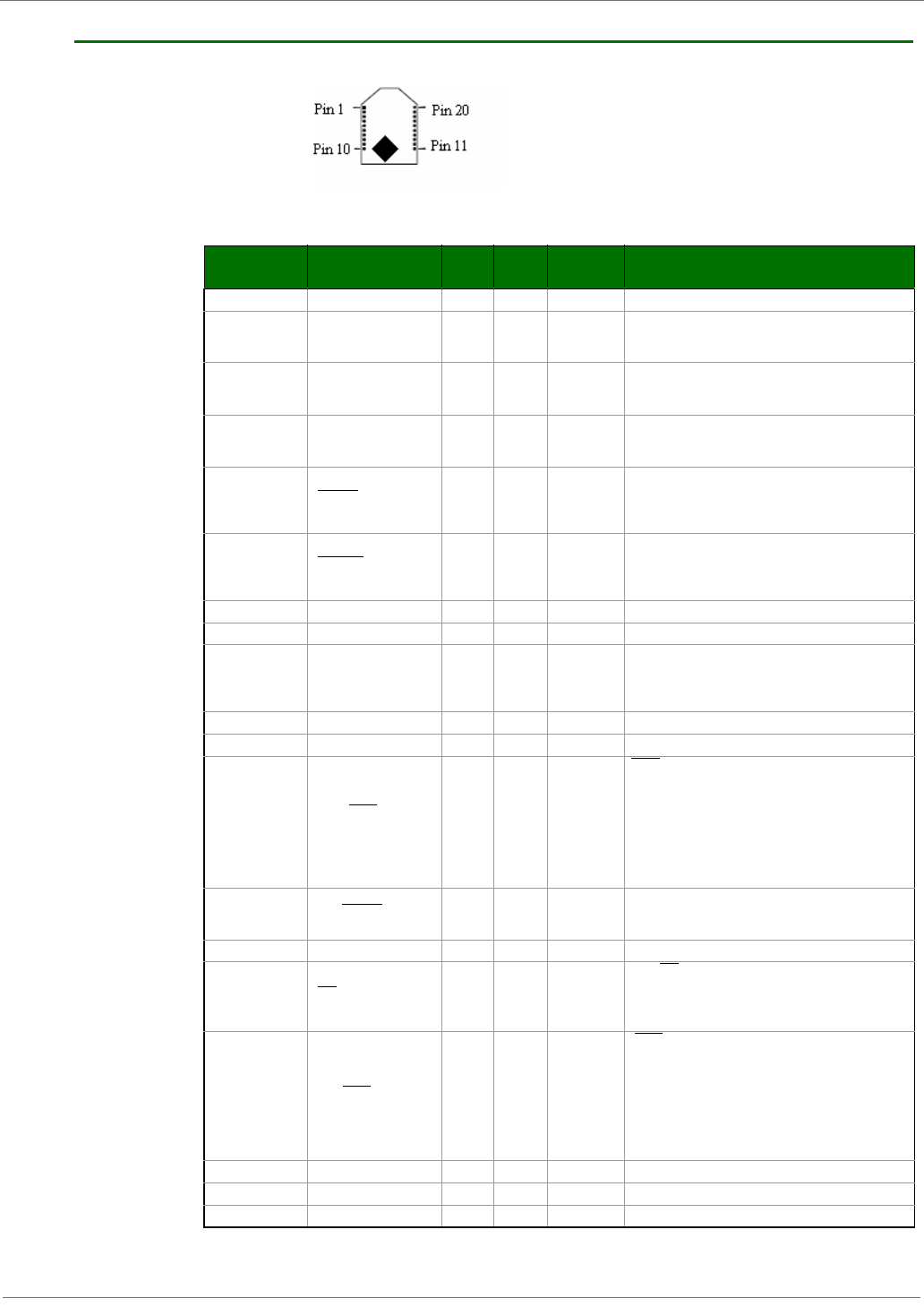
XBee‐PRO™XSCOEMRFModules
©2008DigiInternational,Inc. 7
PreliminaryDraft
1.3. Pin Signals
Figure1‐01. XBee‐PROXSCOEMRFModulePinNumbers(topview,shieldunderneath)
Tab le1‐02. J1PinSignalDescriptions
(Low‐assertedsignalsdistinguishedwithahorizontallineoversignalname.)
Module Pin Public Signal Notes I/O When
Active Function
1 VCC I 3.0v to 3.6v
2 DO (Data Out) O n/a
Serial data exiting the module (to the UART host).
Refer to the Serial Communications section for more
information
3 DI (Data In I n/a
Serial data entering the module (from UART host).
Refer to the Serial Communications section for more
information.
4 DO3 / RX LED O high
Pin is driven high during RF data reception; otherwise,
the pin is driven low. Refer to the CD Command
section to enable.
5 Reset
Has a
10k pull
up
resistor
I/O low
Re-boot module.(minimum pulse is 90us) Open Drain
configuration. Module will drive reset line low
momentarily on reboot and power up.
6 Config
Has a
100k
pull up
resistor
I low / high
Pin can be used as a backup method for entering
Command Mode during power-up. Primary method is
with "+++". Refer to the AT Commandssection for
more information.
7 O Driven high Do not Connect
8 NC Do not Connect
9 DI3 / SLEEP
Has a
100k
pull up
resistor
Ihigh
By default, DI3 pin is not used. To configure this pin to
support Sleep Modes, refer to the Sleep Mode, SM
Command and PW Command sections.
10 GND Ground
11 O Driven high Do not Connect
12 DO2 / CTS / RS-485
Enable Olow
CTS(clear-to-send) flow control - When pin is driven
low, UART host is permitted to send serial data to the
module. Refer to the Serial Communications and CS
Command sections for more information.
----------------------------------------------------------------
RS-485 Enable - To configure this pin to enable RS-
485 (2-wire or 4-wire) communications, refer to the
Serial Communications and CS Command sections.
13 ON / Sleep Ohigh
high = Indicates power is on and module is not in
Sleep Mode. Low = Sleep mode or module is
unpowered
14 ADCVRef I n/a Voltage Reference should be tied to VCC
15 TX / PWR O n/a
low = TX - P i n p u l s e s l o w d u r i n g t r a n s m i s s i o n
--------------------------------------------------------------
high = PWR - Indicates power is on and module is not
in Sleep Mode
16 DI2 / RTS / CMD
Has a
100k
pull
down
resistor
Ilow
RTS (request-to-send) flow control - By default, this
pin is not used. To configure this pin to regulate the
flow of serial data exiting the module, refer to the
S e r i a l C o m m u n i c a t i o n s a n d R T C o m m a n d s e c t i o n s .
---------------------------------------------------------------
CMD -Refer to Binary Commands and RT
Commandsections to enable binary command
programming.
17 O Driven low Do not Connect
18 O Driven low Do not Connect
19 O Driven low Do not Connect
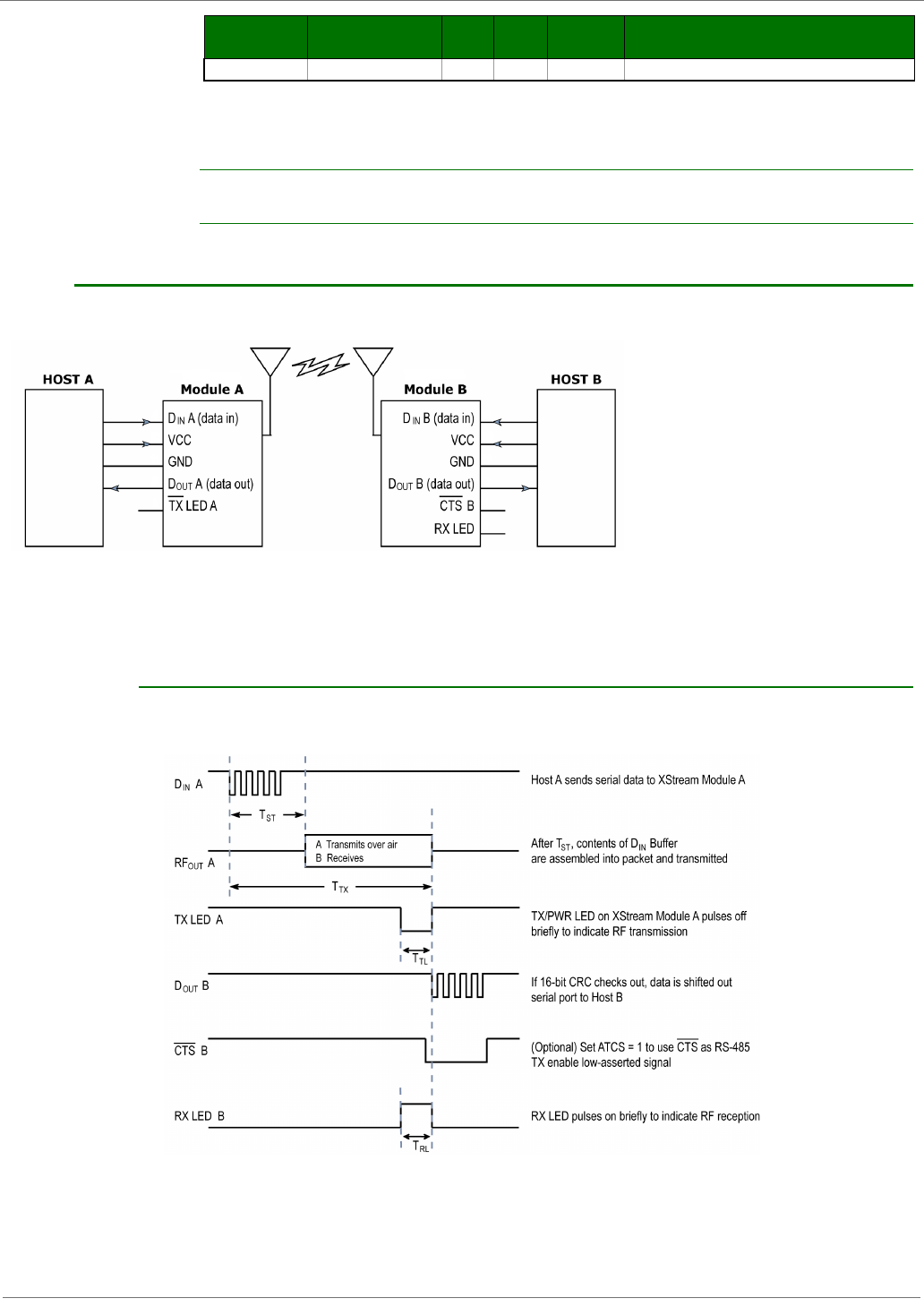
XBee‐PRO™XSCOEMRFModules
©2008DigiInternational,Inc. 8
PreliminaryDraft
*Modulehas10KOhminternalpull‐upresistor
** Modulehas10KOhminternalpull‐downresistor
*** Modulehas100KOhminternalpull‐upresistor
Note: When integrating the XBee-PRO XSC Module with a Host PC Board, all lines that are not used
should be left disconnected (floating).
1.4. Electrical Characteristics
Figure1‐02. SystemBlockDiagram
Basicwirelesslinkbetweenhosts
The data flow sequence is initiated when the first byte of data is received in the DI Buffer of the
transmitting module (XBee-PRO Module A). As long as XBee-PRO Module A is not already
receiving RF data, data in the DI Buffer is packetized, then transmitted over-the-air to XBee-PRO
Module B.
1.4.1. Timing Specifications
Figure1‐03. TimingSpecifications(ʺAʺandʺBʺrefertoFigure1‐02.)
20 O Driven low Do not Connect
Module Pin Public Signal Notes I/O When
Active Function
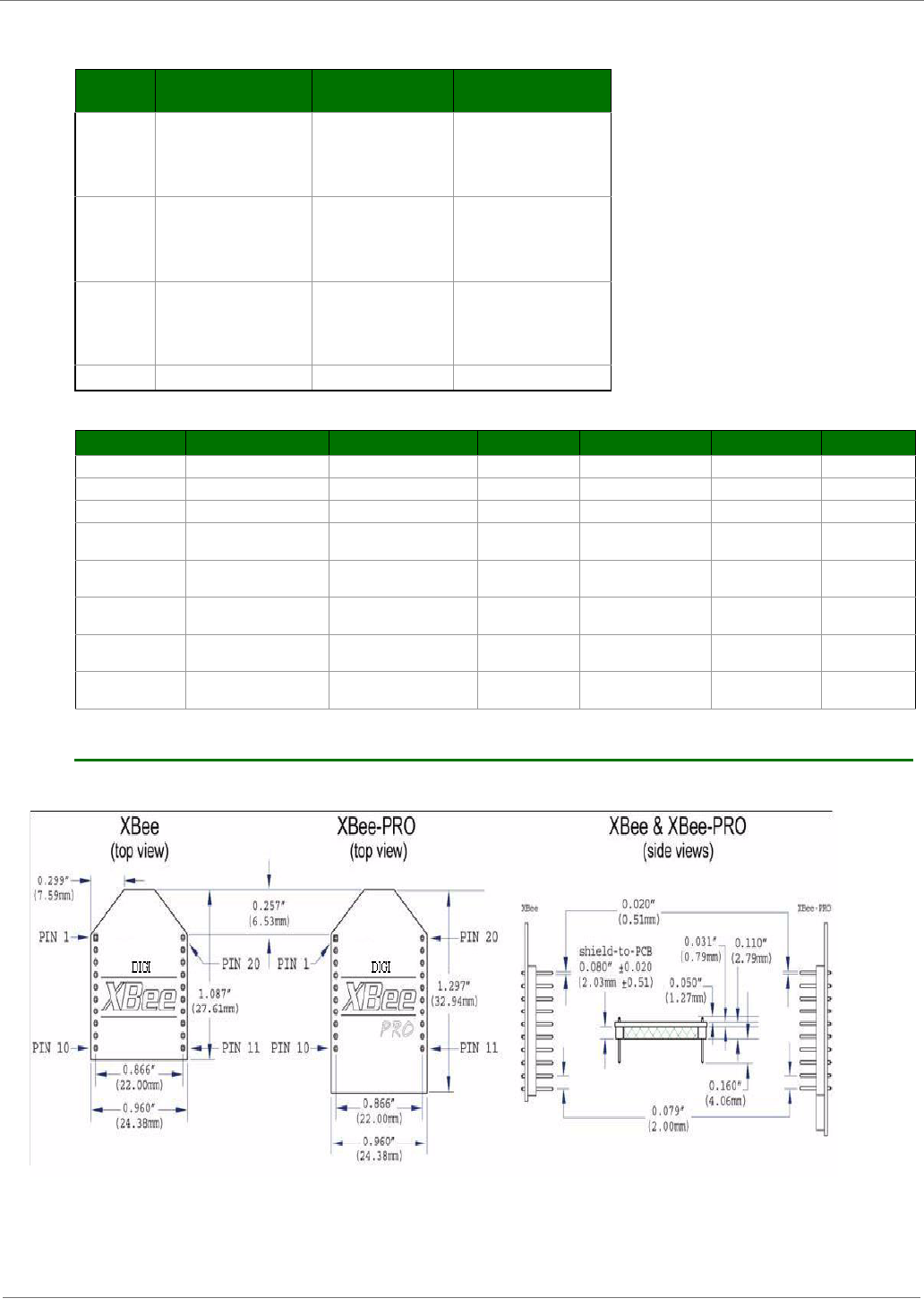
XBee‐PRO™XSCOEMRFModules
©2008DigiInternational,Inc. 9
PreliminaryDraft
Table1‐03. ACCharacteristics(SYparameter=0,symbolscorrespondtoFigure1‐02andFigure1‐03.)
Table1‐04. DCCharacteristics(Vcc=3.0‐3.6VDC)
1.5. Mechanical Drawings
Figure1‐04. MechanicalDrawings
Symbol Description 9600 baud rate
(32 byte packet)
9600 timing
(B=number of bytes)
TTX Latency from the time data
is transmitted until received 72.0 ms
For 0 < B < 40,
T = 46.27 + (0.73 * B) ms
For B >= 39 bytes,
T = 74.80 ms
TTL Time that TX/PWR pin is
driven low 16.8 ms
For 0 < B < 14,
T = 6.50 + (0.8 * B) ms
For B > 13
T = 16.80 ms
TRL Time that RX LED pin is
driven high 25.6 ms
For 0 < B < 37,
T = 1.63 + (0.794 * B)
For B > 36,
T = 30.2 ms
TST Channel Initialization Time 35.0 ms 35.0 ms
Symbol Parameter Condition Min Typical Max Units
Vcc Module Supply Voltage 3.0 3.6 V
VIL Input Low Voltage All input signals -0.3 0.8 V
VIH Input High voltage All input signals 2.0 5.5 V
VOL Output Low-Level
Voltage Iout = Iout_Max 0.4 V
VOH Output High-Level
Voltage Iout = Iout_Max Vcc-0.4 V
IL Input Leakage Current With Pull-up resistors
disabled 40 400 nA
IO1 Output Current pins 2, 15 (Dout, ~TX/
Pwr) 2mA
IO2 Output Current pins 4, 12, 13
(DCD,~CTS,ON/~Sleep) 8mA
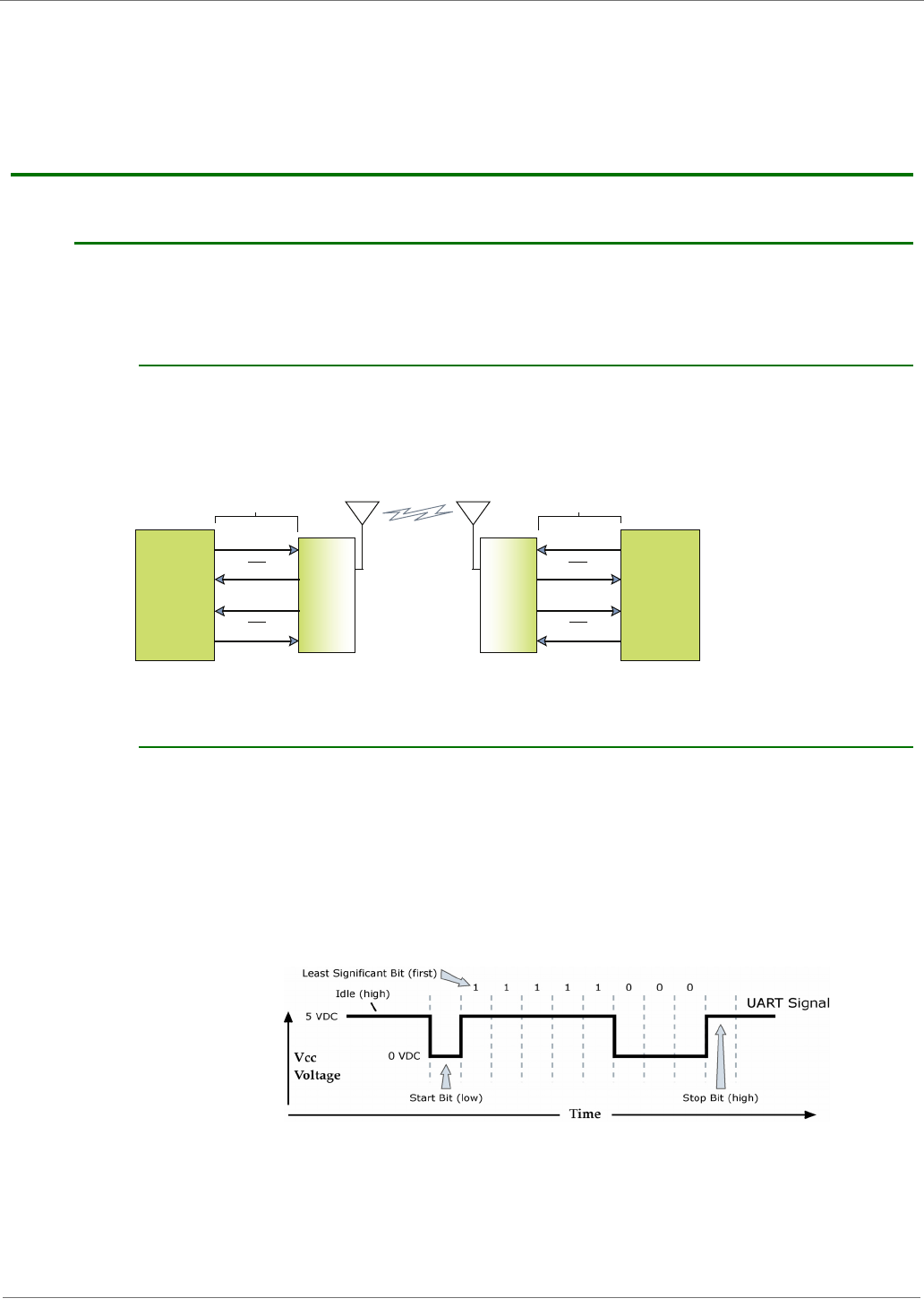
XBee‐PRO™XSCOEMRFModules
©2008DigiInternational,Inc. 10
PreliminaryDraft
2.RFModuleOperation
2.1. Serial Communications
The XBee-PRO™ XSC OEM RF Module interfaces to a host device through a CMOS-level
asynchronous serial port. Through its serial port, the module can communicate with any UART
voltage compatible device or through a level translator to any RS-232/485/422 device.
2.1.1. UART-Interfaced Data Flow
DevicesthathaveaUARTinterfacecanconnectdirectlythroughthepinsoftheXBee‐PROModuleasisshown
inthefigurebelow.
Figure2‐01. SystemDataFlowDiagraminaUART‐interfacedenvironment
(Low‐assertedsignalsdistinguishedwithhorizontallineoversignalname.)
2.1.2. Serial Data
Data enters the XBee-PRO Module through the DI pin as an asynchronous serial signal. The signal
should idle high when no data is being transmitted.
The UART performs tasks, such as timing and parity checking, that are needed for data
communications. Serial communication consists of two UARTs configured with compatible
parameters (baud rate, parity, start bits, stop bits, data bits) to have successful communication.
Each data packet consists of a start bit (low), 8 data bits (least significant bit first) and a stop bit
(high). The following figure illustrates the serial bit pattern of data passing through the module.
Figure2‐02. UARTdatapacket0x1F(decimalnumberʺ31ʺ)astransmittedthroughtheXBee‐PROModule
ExampleDataFormatis8‐N‐1(bits‐parity‐#ofstopbits)
Microcontroller Microcontroller
XStream
Module
XStream
Module
3.3V CMOS Logic
DO (data out)
DI (data in)
CTS
RTS
3.3V CMOS Logic
DO (data out)
DI (data in)
CTS
RTS
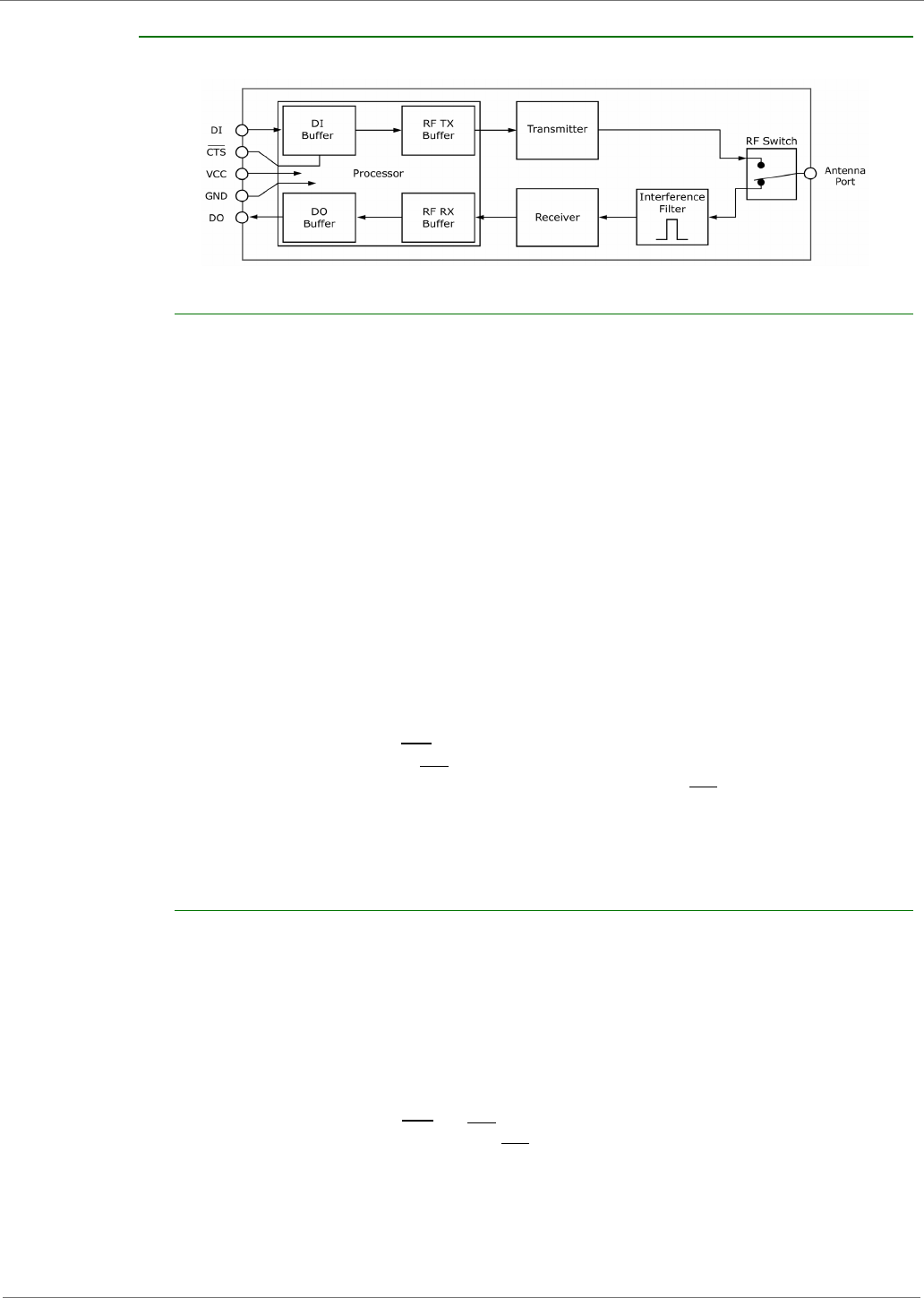
XBee‐PRO™XSCOEMRFModules
©2008DigiInternational,Inc. 11
PreliminaryDraft
2.1.3. Flow Control
Figure2‐03. InternalDataFlowDiagram(Thefivemostcommonly‐usedpinsignalsshown.)
DI (Data In) Buffer and Flow Control
When serial data enters the XBee-PRO Module through the DI Pin, then the data is stored in the DI
Buffer until it can be transmitted.
When the RO parameter threshold is satisfied (refer to Transmit Mode and Command Descriptions
sections for more information), the module attempts to initialize an RF connection. If the module is
already receiving RF data, the serial data is stored in the module's DI Buffer. If the DI buffer
becomes full, hardware or software flow control must be implemented in order to prevent overflow
(loss of data between the host and XBee-PRO OEM RF Module).
How to eliminate the need for flow control:
• Send messages that are smaller than the DI buffer size. The size of the DI buffer varies
according to the packet size and parity setting used.
• Interface at a lower baud rate (BD parameter) than the fixed RF data rate.
Two cases in which the DI Buffer may become full and possibly overflow:
• If the serial interface data rate is set higher than the RF data rate of the module, the module
will receive data from the host faster than it can transmit the data over-the-air.
• If the module is receiving a continuous stream of RF data or if the module is monitoring data
on a network, any serial data that arrives on the DI pin is placed in the DI Buffer. The data in
the DI buffer will be transmitted over-the-air when the module no longer detects RF data in
the network.
Hardware Flow Control (CTS). When the DI buffer is 17 bytes away from being full; by default,
the module de-asserts (high) CTS to signal to the host device to stop sending data [refer to FT
(Flow Control Threshold) and CS (DO2 Configuration) Commands]. CTS is re-asserted after the DI
Buffer has 34 bytes of memory available.
Software Flow Control (XON). XON/XOFF software flow control can be enabled using the FL
(Software Flo DO (Data Out) Buffer and Flow Control
DO (Data Out) Buffer and Flow Control
When RF data is received, the data enters the DO buffer and is then sent out the serial port to a
host device. Once the DO Buffer reaches capacity, any additional incoming RF data is lost.
Two cases in which the DO Buffer may become full and possibly overflow:
• If the RF data rate is set higher than the interface data rate of the module, the module will
receive data from the transmitting module faster than it can send the data to the host.
• If the host does not allow the module to transmit data out from the DO buffer because of
being held off by hardware or software flow control.
Hardware Flow Control (RTS). If RTS is enabled for flow control (RT Parameter = 2), data will
not be sent out the DO Buffer as long as RTS (pin 16) is de-asserted.
Software Flow Control (XOFF). XON/XOFF software flow control can be enabled using the FL
(Software Flow Control) Command. This option only works with ASCII data.
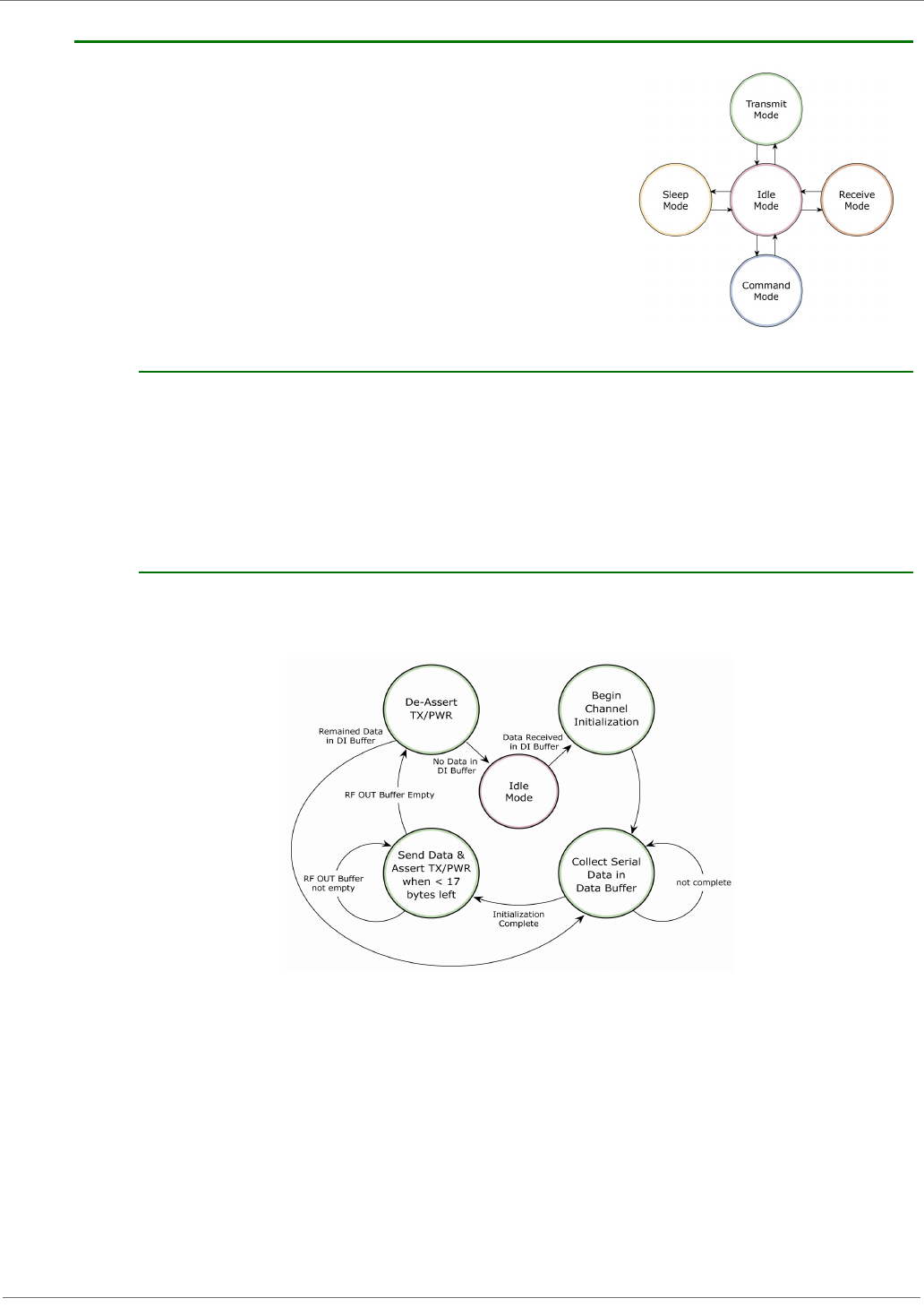
XBee‐PRO™XSCOEMRFModules
©2008DigiInternational,Inc. 12
PreliminaryDraft
2.2. Modes of Operation
XBee-PRO™ XSC RF Modules operate in five modes.
Figure2‐04. ModesofOperation
2.2.1. Idle Mode
When not receiving or transmitting data, the RF module is in Idle Mode. The module shifts into the
other modes of operation under the following conditions:
• Transmit Mode (Serial data is received in the DI Buffer)
• Receive Mode (Valid RF data is received through the antenna)
• Sleep Mode (Sleep Mode condition is met)
• Command Mode (Command Mode Sequence is issued)
2.2.2. Transmit Mode
When the first byte of serial data is received from the UART in the DI buffer, the module attempts
to shift to Transmit Mode and initiate an RF connection with other modules.
Figure2‐05. TransmissionofData
Once in Transmit Mode, the module initializes a communications channel. Channel initialization is
the process of sending an RF initializer that synchronizes receiving modules with the transmitting
module. When streaming multiple RF packets, the RF Initializer is only sent in front of the first
packet. During channel initialization, incoming serial data accumulates in the DI buffer.
After the channel is initialized, data in the DI buffer is grouped into packets (up to 64 bytes in each
packet) and is transmitted. The module continues to transmit data packets until the DI buffer is
empty. Once transmission is finished, the module returns to Idle Mode. This progression is shown
in Figure 2-05.
As the transmitting module nears the end of the transmission, it inspects the DI buffer to see if
more data exists to be transmitted. This could be the case if more bytes arrived from the host
after the transmission began. If more data is pending, the transmitting module assembles a
subsequent packet for transmission.

XBee‐PRO™XSCOEMRFModules
©2008DigiInternational,Inc. 13
PreliminaryDraft
RF Packet
Figure2‐06. RFPacketComponents
* When streaming multiple RF packets, the RF Initializer is only sent in front of the first packet.
RF Initializer
An RF initializer is sent each time a new connection sequence begins. The RF initializer contains
channel information that notifies receiving modules of information such as the hopping pattern
used by the transmitting module. The first transmission always sends an RF initializer.
An RF initializer can be of various lengths depending on the amount of time determined to be
required to prepare a receiving module. For example, a wake-up initializer is a type of RF initializer
used to wake remote modules from Sleep Mode (Refer to the FH, LH, HT and SM Commands for
more information). The length of the wake-up initializer should be longer than the length of time
remote modules are in cyclic sleep.
Header
The header contains network addressing information that filters incoming RF data. The receiving
module checks for a matching VID, Hopping Channel and Destination Address. Data that does not
pass through all three network filter layers is discarded.
Figure2‐07. AddressingLayerscontainedintheHeader
CRC (Cyclic Redundancy Check)
To verify data integrity and provide built-in error checking, a 16-bit CRC (Cyclic Redundancy
Check) is computed for the transmitted data and attached to the end of each RF packet. On the
receiving end, the receiving module computes the CRC on all incoming RF data. Received data that
has an invalid CRC is discarded [See Receive Mode section, next page].
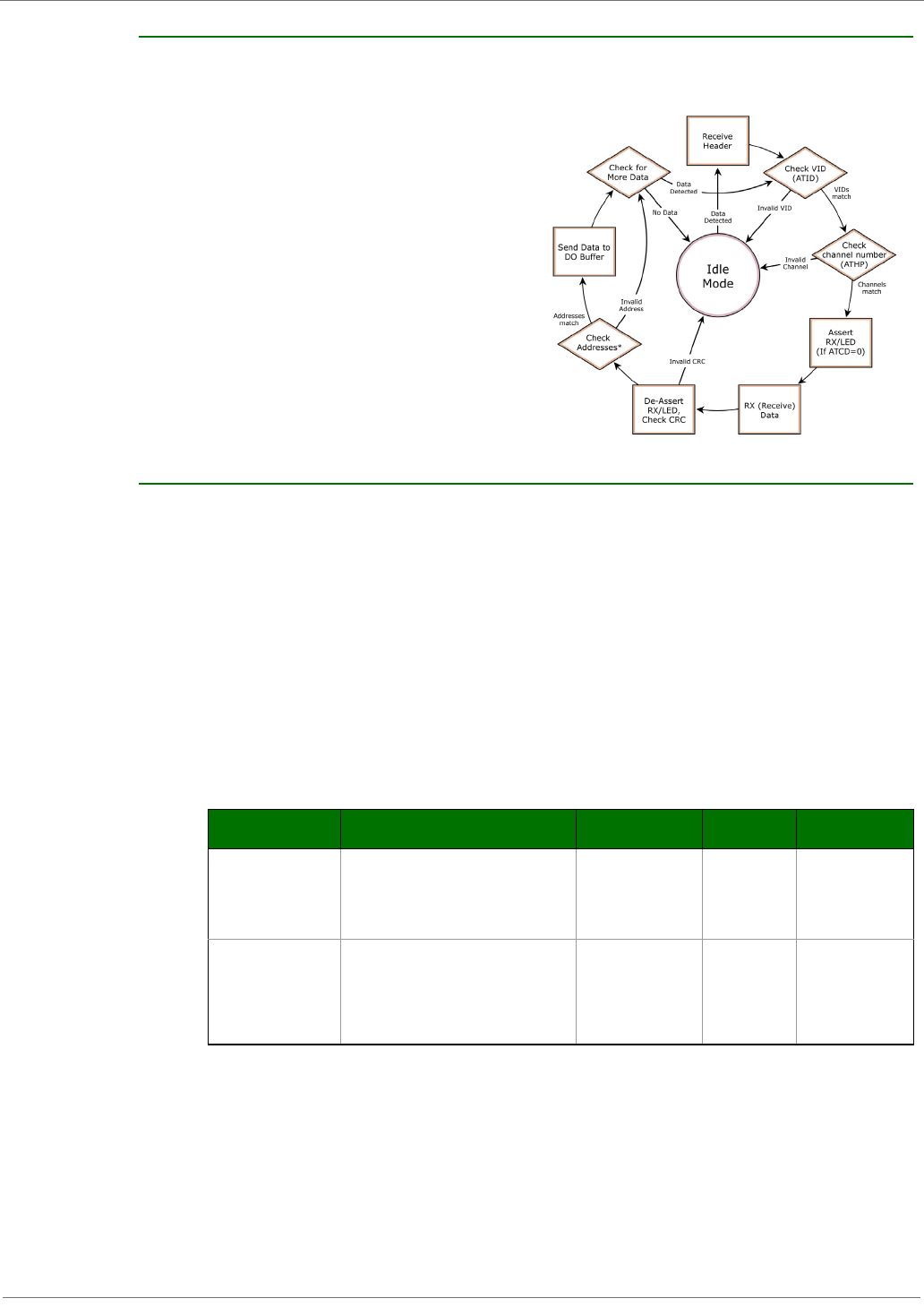
XBee‐PRO™XSCOEMRFModules
©2008DigiInternational,Inc. 14
PreliminaryDraft
2.2.3. Receive Mode
If a module detects RF data while operating in Idle Mode, the module transitions into Receive Mode
to start receiving RF packets.
Figure2‐08. ReceptionofRFData
After a packet is received, the module
checks the CRC (cyclic redundancy check)
to ensure that the data was transmitted
without error. If the CRC data bits on the
incoming packet are invalid, the packet is
discarded. If the CRC is valid, the packet
proceeds to the DO Buffer.
The module returns to Idle Mode after valid
RF data is no longer detected or after an
error is detected in the received RF data. If
serial data is stored in the DI buffer while
the module is in Receive Mode, the serial
data will be transmitted after the module is
finished receiving data and returns to Idle
Mode.
2.2.4. Sleep Mode
Sleep Modes enable the XBee-PRO Module to operate at minimal power consumption when not in
use. Three Sleep Mode options are available:
•Pin Sleep
•Cyclic Sleep
For the module to transition into Sleep Mode, the module must have a non-zero SM (Sleep Mode)
Parameter and one of the following must occur:
• The module is idle (no data transmission or reception) for a user-defined period of time [Refer
to the ST (Time before Sleep) Command].
• SLEEP is asserted (only for Pin Sleep option).
In Sleep Mode, the module will not transmit or receive data until the module first transitions to
Idle Mode. All Sleep Modes are enabled and disabled using SM Command. Transitions into and out
of Sleep Modes are triggered by various events as shown in the table below.
Tab le2‐01. SummaryofSleepModeConfigurations
Pin Sleep (SM = 1)
Pin Sleep requires the least amount of power. In order to achieve this state, SLEEP pin must be
asserted (high). The module remains in Pin Sleep until the SLEEP pin is de-asserted.
After enabling Pin Sleep, the SLEEP pin controls whether the XBee-PRO Module is active or in
Sleep Mode. When SLEEP is de-asserted (low), the module is fully operational. When SLEEP is
asserted (high), the module transitions to Sleep Mode and remains in its lowest power-consuming
state until the SLEEP pin is de-asserted. SLEEP is only active if the module is setup to operate in
this mode; otherwise the pin is ignored.
Sleep Mode
Setting
Transition into
Sleep Mode
Transition out of
Sleep Mode
Related
Commands
Typical Power
Consumption
Pin Sleep
(SM = 1)
Microcontroller can shut down and wake
modules by asserting (high) SLEEP (pin 2).
Note: The module will complete a
transmission or reception before activating
Pin Sleep.
De-assert (low)
SLEEP (pin 2). SM 50 µA
Cyclic Sleep
(SM = 3-8)
Automatic transition to Sleep Mode occurs
in cycles as defined by the SM (Sleep
Mode) Command.
Note: The cyclic sleep time interval must be
shorter than the “Wake-up Initializer Timer”
(set by LH Command).
After the cyclic sleep
time interval elapses.
Note: Module can be
forced into Idle Mode
if PW (Pin Wake-up)
Command is issued.
SM, ST, HT,
LH, PW
76 µA
when sleeping
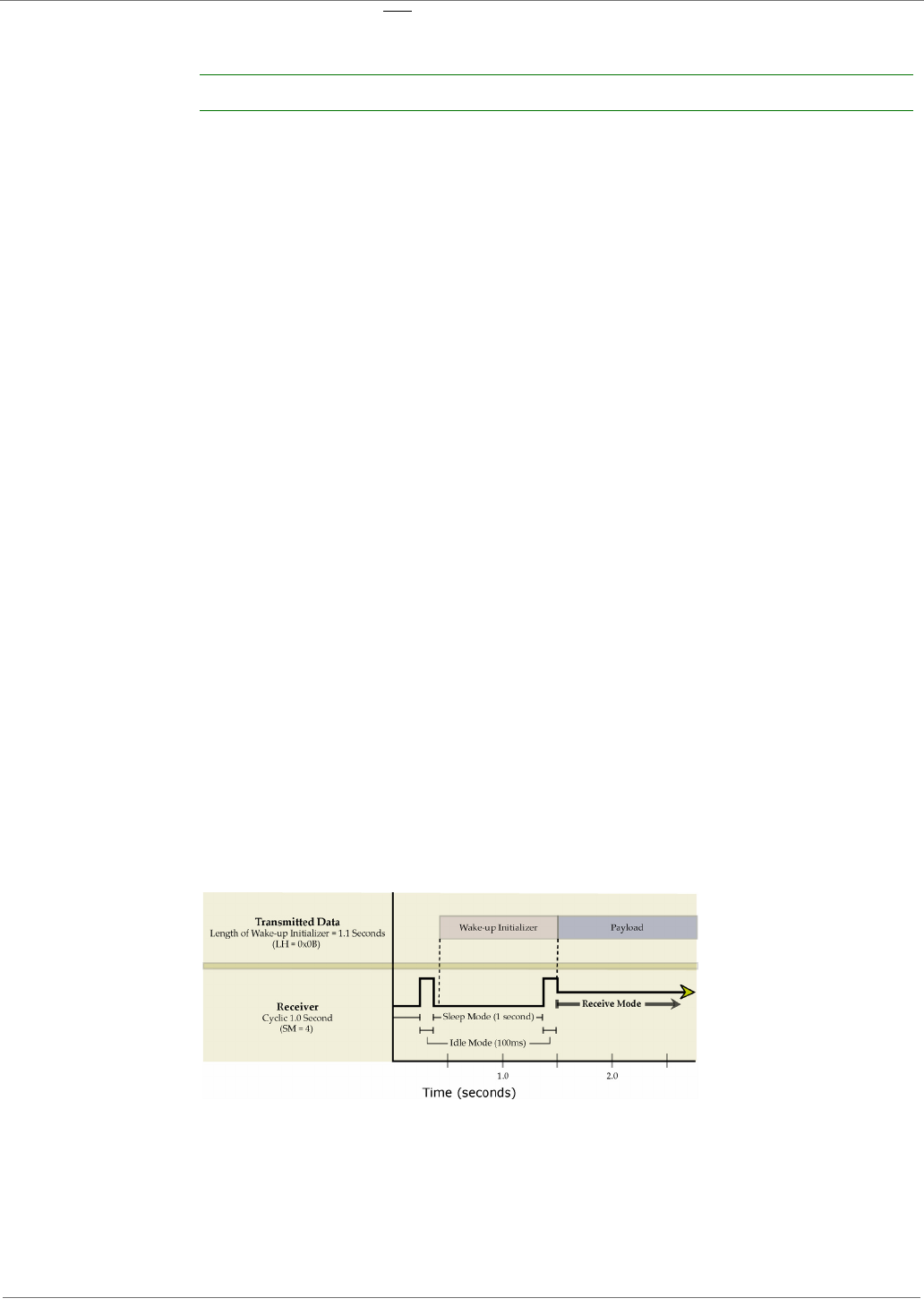
XBee‐PRO™XSCOEMRFModules
©2008DigiInternational,Inc. 15
PreliminaryDraft
Once in Pin Sleep Mode, CTS is de-asserted (high), indicating that data should not be sent to the
module. The PWR pin is also de-asserted (low) when the module is in Pin Sleep Mode.
Note: The module will complete a transmission or reception before activating Pin Sleep.
Cyclic Sleep (SM = 3-8)
Cyclic Sleep is the Sleep Mode in which the XBee-PRO Module enters into a low-power state and
awakens periodically to determine if any transmissions are being sent.
When Cyclic Sleep settings are enabled, the XBee-PRO Module goes into Sleep Mode after a user-
defined period of inactivity (no transmission or reception on the RF channel). The user-defined
period is determined by ST (Time before Sleep) Command.
While the module is in Cyclic Sleep Mode, is de-asserted (high) to indicate that data should not
be sent to the module during this time. When the module awakens to listen for data, is asserted
and any data received on the DI Pin is transmitted. The PWR pin is also de-asserted (low) when
the module is in Cyclic Sleep Mode.
The module remains in Sleep Mode for a user-defined period of time ranging from 0.5 seconds to
16 seconds (SM Parameters 3 through 8). After this interval of time, the module returns to Idle
Mode and listens for a valid data packet for 100 ms. If the module does not detect valid data (on
any frequency), the module returns to Sleep Mode. If valid data is detected, the module
transitions into Receive Mode and receives incoming RF packets. The module then returns to Sleep
Mode after a Period of inactivity that is determined by ST "Time before Sleep" Command.
The module can also be configured to wake from cyclic sleep when SLEEP (pin 2) is de-asserted
(low). To configure a module to operate in this manner, PW (Pin Wake-up) Command must be
issued. Once SLEEP is de-asserted, the module is forced into Idle Mode and can begin transmitting
or receiving data. It remains active until no data is detected for the period of time specified by the
ST Command, at which point it resumes its low-power cyclic state.
Note: The cyclic interval time defined by SM (Sleep Mode) Command must be shorter than the
interval time defined by LH (Wake-up Initializer Timer).
For example: If SM=4 (Cyclic 1.0 second sleep), the LH Parameter should equal 0x0B ("1.1"
seconds). With these parameters set, there is no risk of the receiving module being asleep for the
duration of wake-up initializer transmission. "Cyclic Scanning" explains in further detail the
relationship between "Cyclic Sleep" and "Wake-up Initializer Timer"
Cyclic Scanning. Each RF transmission consists of an RF Initializer and payload. The wake-up
initializer contains initialization information and all receiving modules must wake during the wake-
up initializer portion of data transmission in order to be synchronized with the transmitting module
and receive the data.
Figure2‐09. CorrectConfiguration(LH>SM)
Lengthofthewake‐upinitializerexceedsthetimeintervalofCyclicSleep.Thereceiverisguaranteedtodetect
thewake‐upinitializerandreceivetheaccompanyingpayloaddata.
Figure2‐010.IncorrectConfiguration(LH<SM)
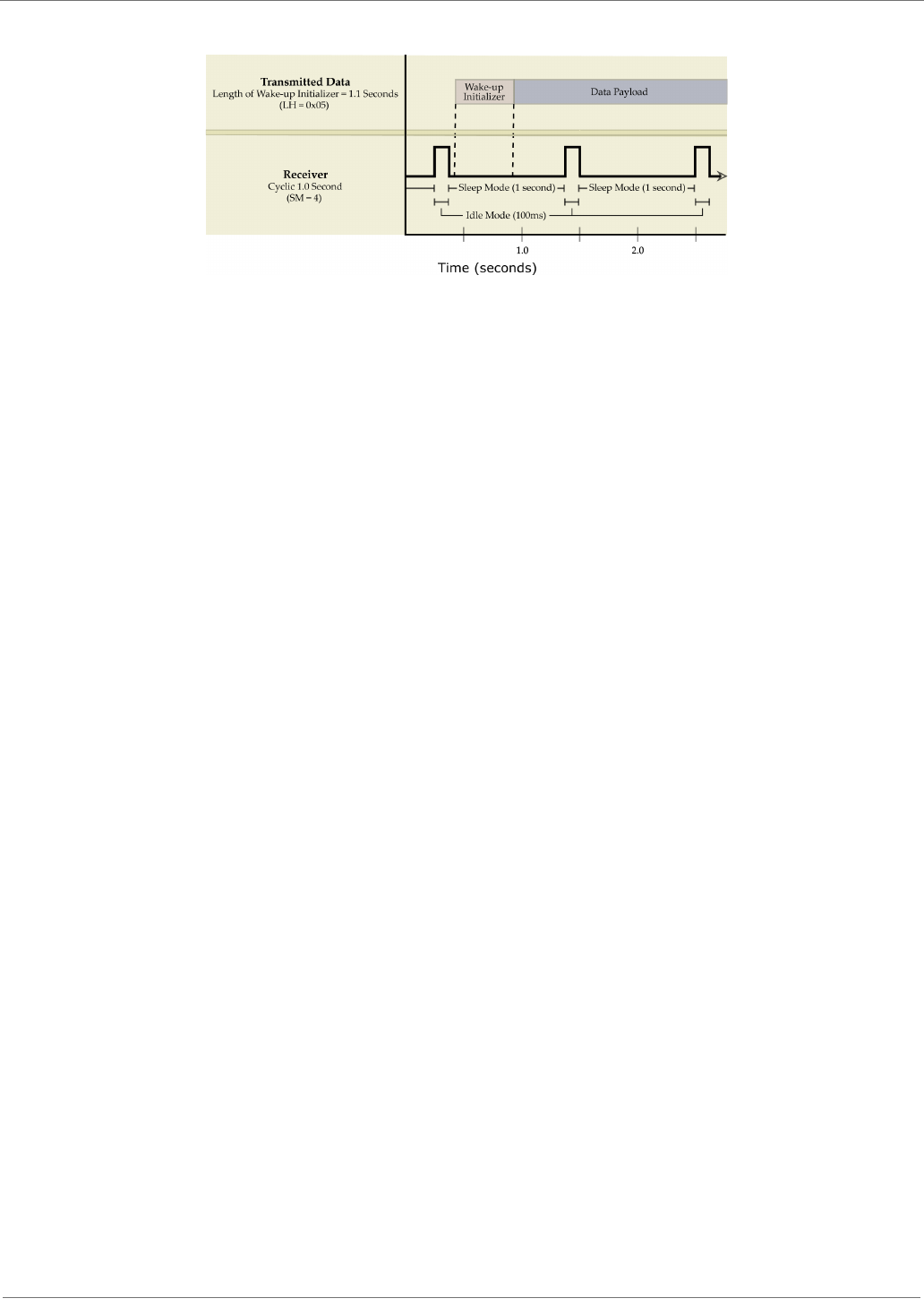
XBee‐PRO™XSCOEMRFModules
©2008DigiInternational,Inc. 16
PreliminaryDraft
Lengthofwake‐upinitializerisshorterthanthetimeintervalofCyclicSleep.Thisconfigurationisvulnerableto
thereceiverwakingandmissingthewake‐upinitializer(andthereforealsotheaccompanyingpayloaddata).
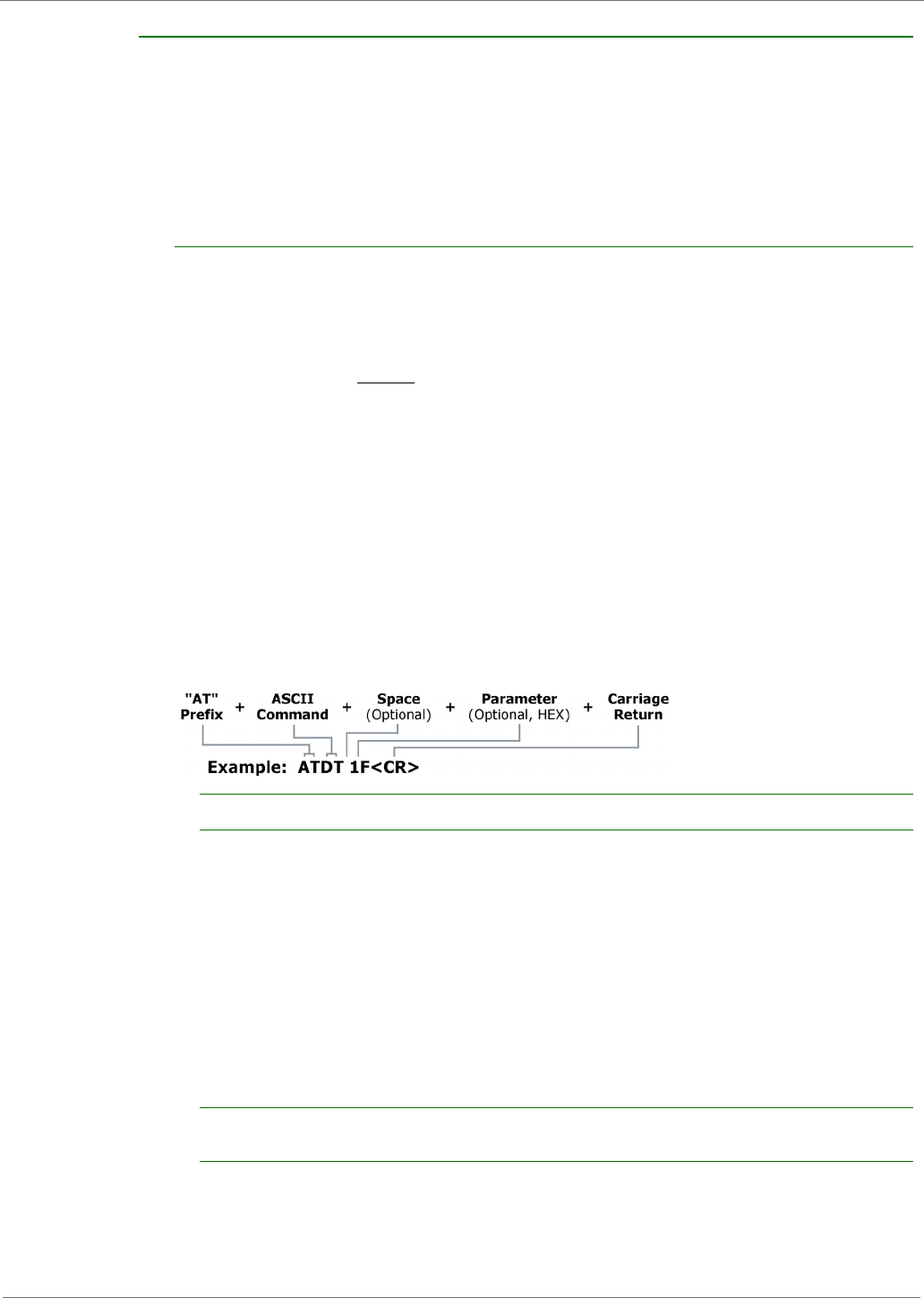
XBee‐PRO™XSCOEMRFModules
©2008DigiInternational,Inc. 17
PreliminaryDraft
2.2.5. Command Mode
To modify or read module parameters, the module must first enter into Command Mode, the state in
which incoming characters are interpreted as commands. Two command types are available for pro-
gramming the module:
• AT Commands
• Binary Commands
For modified parameter values to persist in the module registry, changes must be saved to non-vola-
tile memory using WR (Write) Command. Otherwise, parameters are restored to previously saved val-
ues after the module is powered off and then on again.
AT Commands
To Enter AT Command Mode:
• Send the 3-character command sequence "+++" and observe guard times before and after
the command characters. [refer to ‘Default AT Command Mode Sequence’ below.] The ‘Termi-
nal’ tab (or other serial communications software) of the X-CTU Software can be used to enter
the sequence.
[OR]
• Assert (low) the CONFIG pin and either turn the power going to the module off and back on.
(If using a Digi XBIB-R Interface Board, the same result can be achieved by holding the Data-
In line low (also known as a break) while rebooting the module by pressing the reset button
on the module assembly [module assembly = module mounted to an interface board]).
Default AT Command Mode Sequence (for transition to Command Mode):
• No characters sent for one second [refer to the BT (Guard Time Before) Command]
• Input three plus characters (“+++”) within one second
[refer to the CC (Command Sequence Character) Command.]
• No characters sent for one second [refer to the AT (Guard Time After) Command.]
To Send AT Commands:
Send AT commands and parameters using the syntax shown below.
Figure2‐11.SyntaxforsendingATCommands
To read a parameter value stored in the module register, leave the parameter field blank.
The preceding example would change the module’s Destination Address to "0x1F". To store the
new value to non-volatile (long term) memory, the Write (ATWR) command must subsequently be
sent before powering off the module.
System Response. When a command is sent to the module, the module will parse and execute
the command. Upon successful execution of a command, the module returns an “OK” message. If
execution of a command results in an error, the module returns an “ERROR” message.
To Exit AT Command Mode:
• If no valid AT Commands are received within the time specified by CT (Command Mode Time-
out) Command, the module automatically returns to Idle Mode.
[OR]
• Send ATCN (Exit Command Mode) Command.
For an example of programming the RF module using AT Commands and descriptions of each config-
urable parameter, refer to the "RF Module Configuration" chapter.
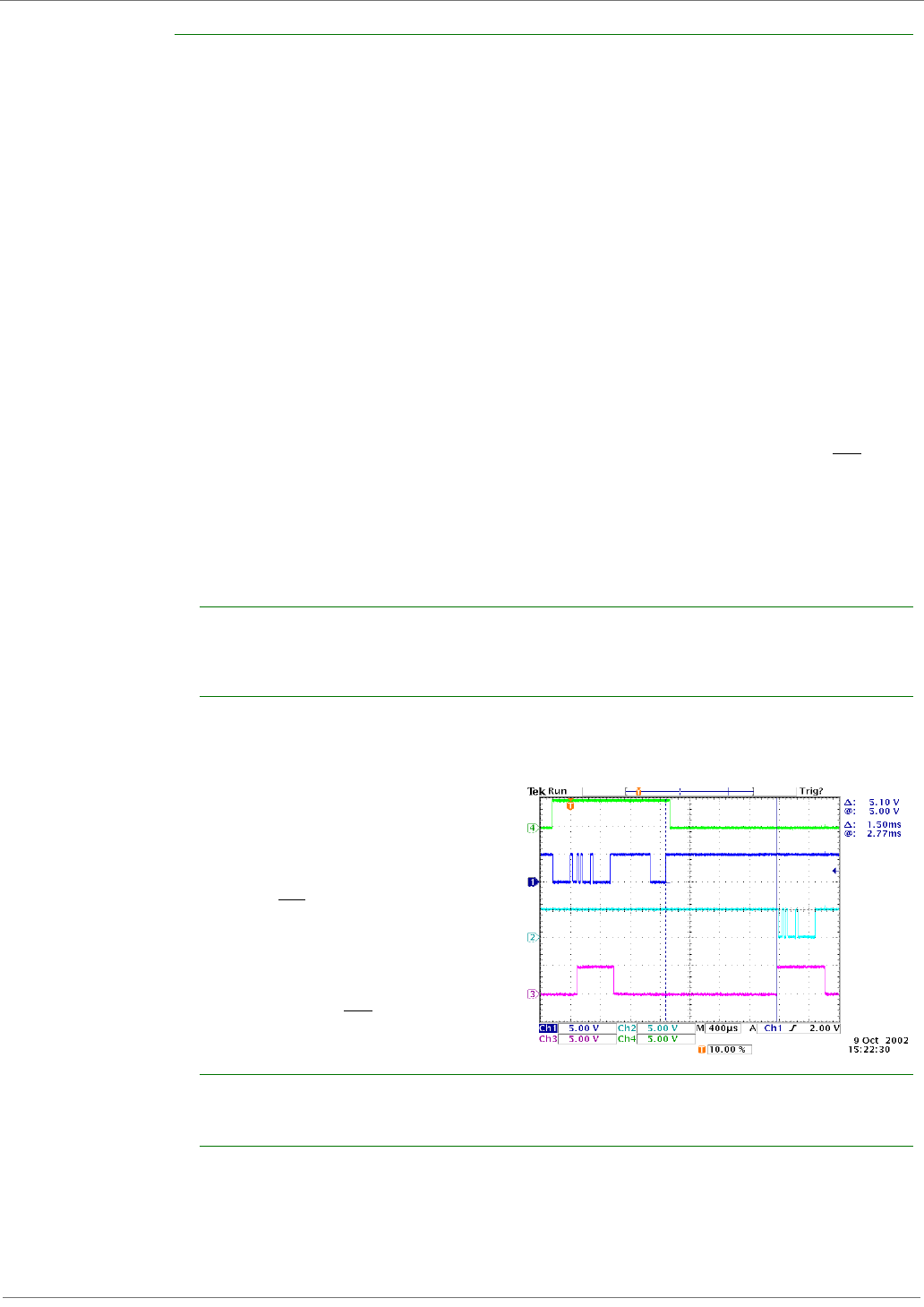
XBee‐PRO™XSCOEMRFModules
©2008DigiInternational,Inc. 18
PreliminaryDraft
Binary Commands
Sending and receiving parameter values using binary commands is the fastest way to change
operating parameters of the module. Binary commands are used most often to sample signal
strength (RS parameter) and/or error counts; or to change module addresses and channels for
polling systems when a quick response is necessary. Since the sending and receiving of parameter
values takes place through the same data path as 'live' data (received RF payload), interference
between the two types of data can be a concern.
Common questions regarding the use of binary commands:
• What are the implications of asserting CMD while live data is being sent or received?
• After sending serial data, is there a minimum time delay before CMD can be asserted?
• Is a time delay required after CMD is de-asserted before payload data can be sent?
• How to discern between live data and data received in response to a command?
CMD (pin 5) must be asserted in order to send binary commands to the module. The CMD pin can
be asserted to recognize binary commands anytime during the transmission or reception of data.
The status of the CMD signal is only checked at the end of the stop bit as the byte is shifted into
the serial port. The application does not allow control over when data is received, except by
waiting for dead time between bursts of communication.
If the command is sent in the middle of a stream of payload data to be transmitted, the command
will essentially be executed in the order it is received. If the radio is continuously receiving data,
the radio will wait for a break in the received data before executing the command. The CTS signal
will frame the response coming from the binary command request [Figure 2-012].
A minimum time delay of 100 µs (after the stop bit of the command byte has been sent) must be
observed before pin 5 can be de-asserted. The command executes after all parameters associated
with the command have been sent. If all parameters are not received within 0.5 seconds, the
module aborts the command and returns to Idle Mode.
Note: When parameters are sent, they are two bytes long with the least significant byte sent first.
Binary commands that return one parameter byte must be written with two parameter bytes.
Refer to “Programming Examples” section [pXX] for a binary programming example.
Commands can be queried for their current value by sending the command logically ORed (bit-
wise) with the value 0x80 (hexadecimal) with CMD asserted. When the binary value is sent (with
no parameters), the current value of the command parameter is sent back through the DO pin.
Figure2‐012.BinaryCommandWritethenRead
Signal#4isCMD(pin16)
Signal#1istheDIN(pin3)signal
totheradio
Signal#2istheDOUT(pin2)signal
fromtheradio
Signal#3isCTS(pin12)
In this graph, a value was written to a
register and then read out to verify it.
While not in the middle of other received
data, note that the CTS signal outlines the
data response out of the module.
IMPORTANT: For the XBee-PRO Module to recognize a binary command, the RT (DI2 Configuration)
parameter must be set to one. If binary programming is not enabled (RT ? 1), the module will not rec-
ognize that the CMD pin is asserted and therefore will not recognize the data as binary commands.

XBee‐PRO™XSCOEMRFModules
©2008DigiInternational,Inc. 19
PreliminaryDraft
3.RFModuleConfiguration
3.1. XBEE-PROProgramming Examples
For information about entering and exiting AT and Binary Command Modes, refer to the Command
Mode section.
3.1.1. AT Commands
To Send AT Commands (Using the ‘Terminal’ tab of the X-CTU Software)
Note: When using X-CTU Software to program a module, PC com port settings must match the baud
(interface data rate), parity & stop bits parameter settings of the module. Use the 'Com Port Setup'
section of the “PC Settings” tab to configure PC com port settings to match those of the module.
3.1.2. Binary Commands
To Send Binary Commands
Note: CTS )is de-asserted high when commands are being executed. Hardware flow control must be
disabled as CTS will hold off parameter bytes.
Example: Utilize the 'Terminal' tab of the X-CTU Software to change the module's DT (Destina-
tion Address) parameter and save the new address to non-volatile memory. This example
requires the installation of Digi’s X-CTU Software and a serial connection to a PC.
Select the ‘Terminal’ tab of the X-CTU Software and enter the following command lines:
Method 1 (One line per command)
Send AT Command
+++
ATDT <Enter>
ATDT1A0D <Enter>
ATWR <Enter>
ATCN <Enter>
System Response
OK <CR> (Enter into Command Mode)
{current value} <CR> (Read Destination Address)
OK <CR> (Modify Destination Address)
OK <CR> (Write to non-volatile memory)
OK <CR> (Exit Command Mode)
Method 2 (Multiple commands on one line)
Send AT Command
+++
ATDT <Enter>
ATDT1A0D,WR,CN <Enter>
System Response
OK <CR> (Enter into Command Mode)
{current value} <CR> (Read Destination Address)
OK <CR> (Execute commands)
Example: Use binary commands to change the XBee-PRO Module's destination address to
0x1A0D and save the new address to non-volatile memory.
1. RT Command must be set to "1" in AT Command Mode to enable binary programming.
2. Assert CMD (Pin 16 is driven high). (Enter Binary Command Mode)
3. Send Bytes (parameter bytes must be 2 bytes long):
00
0D
1A
08
(Send DT (Destination Address) Command)
(Least significant byte of parameter bytes
(Most significant byte of parameter bytes)
(Send WR (Write) Command)
4. De-assert CMD (Pin 16 is driven
low)
(Exit Binary Command Mode)
Note:Donotsendcom‐
mandstothemodule
duringflashprogram‐
ming(whenparameters
arebeingwrittentothe
moduleregistry).
WaitfortheʺOKʺsys‐
temresponsethatfol‐
lowstheATWR
commandbeforeenter‐
ingthenextcommand
oruseflowcontrol.
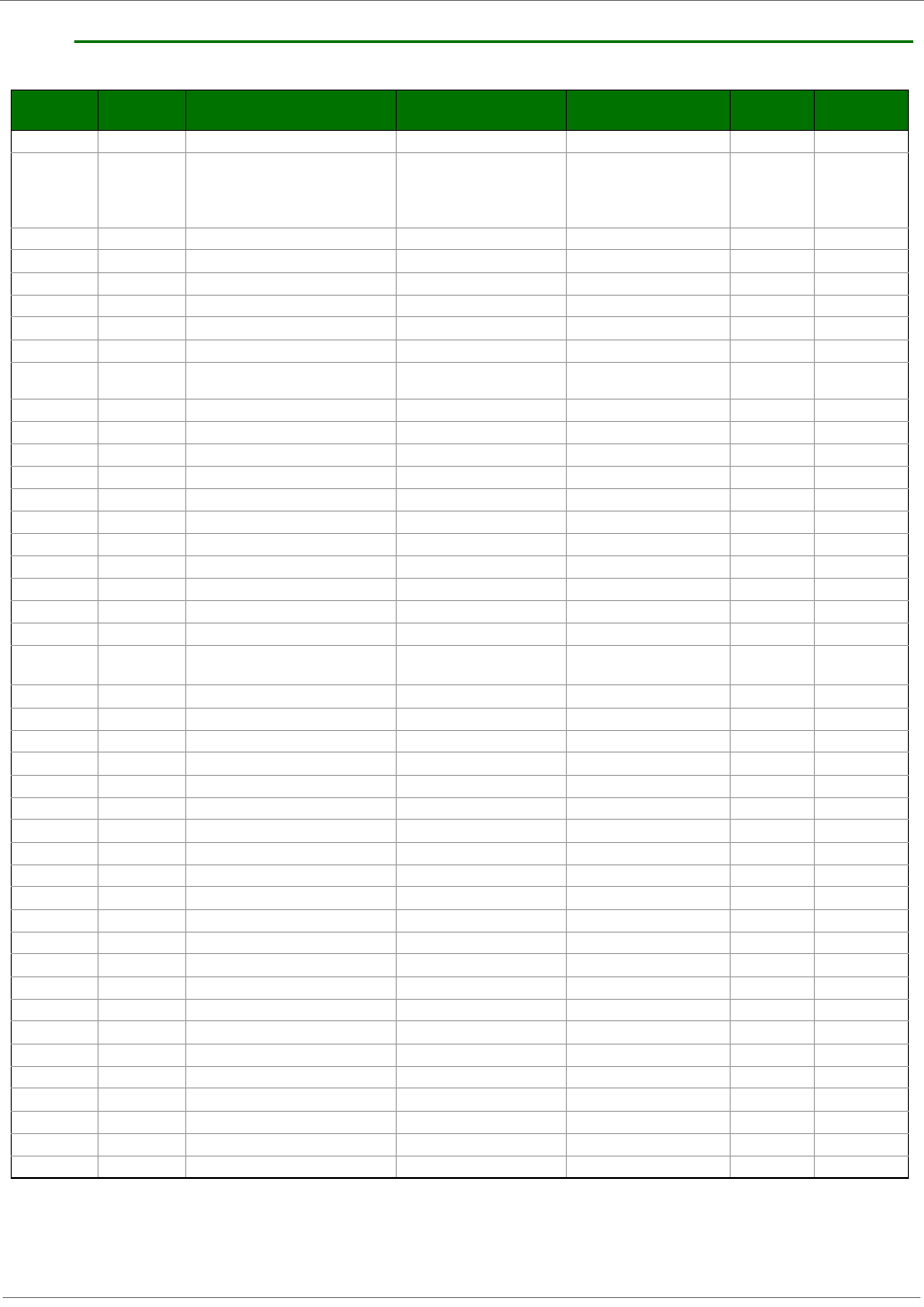
XBee‐PRO™XSCOEMRFModules
©2008DigiInternational,Inc. 20
PreliminaryDraft
3.2. Command Reference Table
Table3‐01. ATCommands(TheRFModuleexpectsnumericalvaluesinhexadecimal.ʺdʺdenotesdecimalequivalent.))
.NOTE: AT Commands issued without a parameter value will return the currently stored parameter.
AT
Command
Binary
Command AT Command Name Range Command Category # Bytes
Returned
Factory
Default
AT 0x05 (5d) Guard Time After 0x02 – 0xFFFF [x 100 msec] Command Mode Options 2 0x0A (10d)
BD 0x15 (21d) Interface Data Rate
Standard baud rates:
0 – 6
Non-standard baud rates:
0x7D – 0xFFFF
Serial Interfacing 2 0x03 9600bps
BT 0x04 (4d) Guard Time Before 2 – 0xFFFF [x 100 msec] Command Mode Options 2 0x0A (10d)
CC 0x13 (19d) Command Sequence Character 0x20 – 0x7F Command Mode Options 1 0x2B (“+”)
CD 0x28 (40d) DO3 Configuration 0 - 4 Serial Interfacing 1 0
CN 0x09 (9d) Exit AT Command Mode - Command Mode Options - -
CS 0x1F (31d) DO2 Configuration 0 – 4 Serial Interfacing 1 0
CT 0x06 (6d) Command Mode Timeout 0x02 – 0xFFFF [x 100 msec] Command Mode Options 2 0xC8 (200d)
DB RSSI level in dBm of the most recent
packet 0 - 0x70 [read-only] Diagnostics 1
DT 0x00 (0d) Destination Address 0 – 0xFFFF Networking 2 0
E0 0x0A (10d) Echo Off - Command Mode Options - -
E1 0x0B (11d) Echo On - Command Mode Options - -
ER 0x0F (15d) Receive Error Count 0 – 0xFFFF Diagnostics 2 0
FH 0x0D (13d) Force Wake-up Initializer - Sleep (Low Power) - -
FL 0x07 (7d) Software Flow Control 0 – 1 Serial Interfacing 1 0
FR Forces the module to Reset (Special)
FT 0x24 (36d) Flow Control Threshold 0 – (DI buffer – 0x11) [bytes] Serial Interfacing 2 varies
GD 0x10 (16d) Receive Good Count 0 – 0xFFFF Diagnostics 2 0
HP 0x11 (17d) Hopping Channel 0 – 6 Networking 1 0
HT 0x03 (3d) Time before Wake-up Initializer 0 – 0xFFFF [x 100 msec] Sleep (Low Power) 2 0xFFFF
ID 0x27 (39d) Module VID User settable: 0x10 - 0x7FFF
Read-only: 0x8000 – 0xFFFF Networking 2 -
LH 0x0C (12d) Wake-up Initializer Timer 0 – 0xFF [x 100 msec] Sleep (Low Power) 1 1
MK 0x12 (18d) Address Mask 0 – 0xFFFF Networking 2 0xFFFF
NB 0x23 (35d) Parity 0 – 4 Serial Interfacing 1 0
PC 0x1E (30d) Power-up Mode 0 – 1 Command Mode Options 1 0
PW 0x1D (29d) Pin Wake-up 0 – 1 Sleep (Low Power) 1 0
RE 0x0E (14d) Restore Defaults - (Special) - -
RN 0x19 (25d) Delay Slots 0 – 0xFF [slots] Networking 1 0
RO 0x21 (33d) Packetization Timeout 0 – 0xFFFF [x 200 µsec] Serial Interfacing 2 0
RP 0x22 (34d) RSSI PWM Timer 0 - 0x7F [x 100 msec] Diagnostics 1 0
RR 0x18 (24d) Retries 0 – 0xFF Networking 1 0
RS 0x1C (28d) RSSI 0x06 – 0x36 [read-only] Diagnostics 1 -
RT 0x16 (22d) DI2 Configuration 0 - 2 Serial Interfacing 1 0
SB 0x36 (54d) Stop Bits 0 - 1 Serial Interfacing 1 0
SH 0x25 (37d) Serial Number High 0 – 0xFFFF [read-only] Diagnostics 2 -
SL 0x26 (38d) Serial Number Low 0 – 0xFFFF [read-only] Diagnostics 2 -
SM 0x01 (1d) Sleep Mode 0, 1, 3 - 8 Sleep (Low Power) 1 0
ST 0x02 (2d) Time before Sleep 0x10 – 0xFFFF [x 100 msec] Sleep (Low Power) 2 0x64 (100d)
SY 0x17 (23d) Time before Initialization 0 – 0xFF [x 100 msec] Networking 1 0 (disabled)
TR 0x1B (27d) Transmit Error Count 0 – 0xFFFF Diagnostics 2 0
TT 0x1A (26d) Streaming Limit 0 – 0xFFFF [0 = disabled] Networking 2 0xFFFF
VR 0x14 (20d) Firmware Version 0 - 0xFFFF [read-only] Diagnostics 2 -
WR 0x08 (8d) Write - (Special) - -
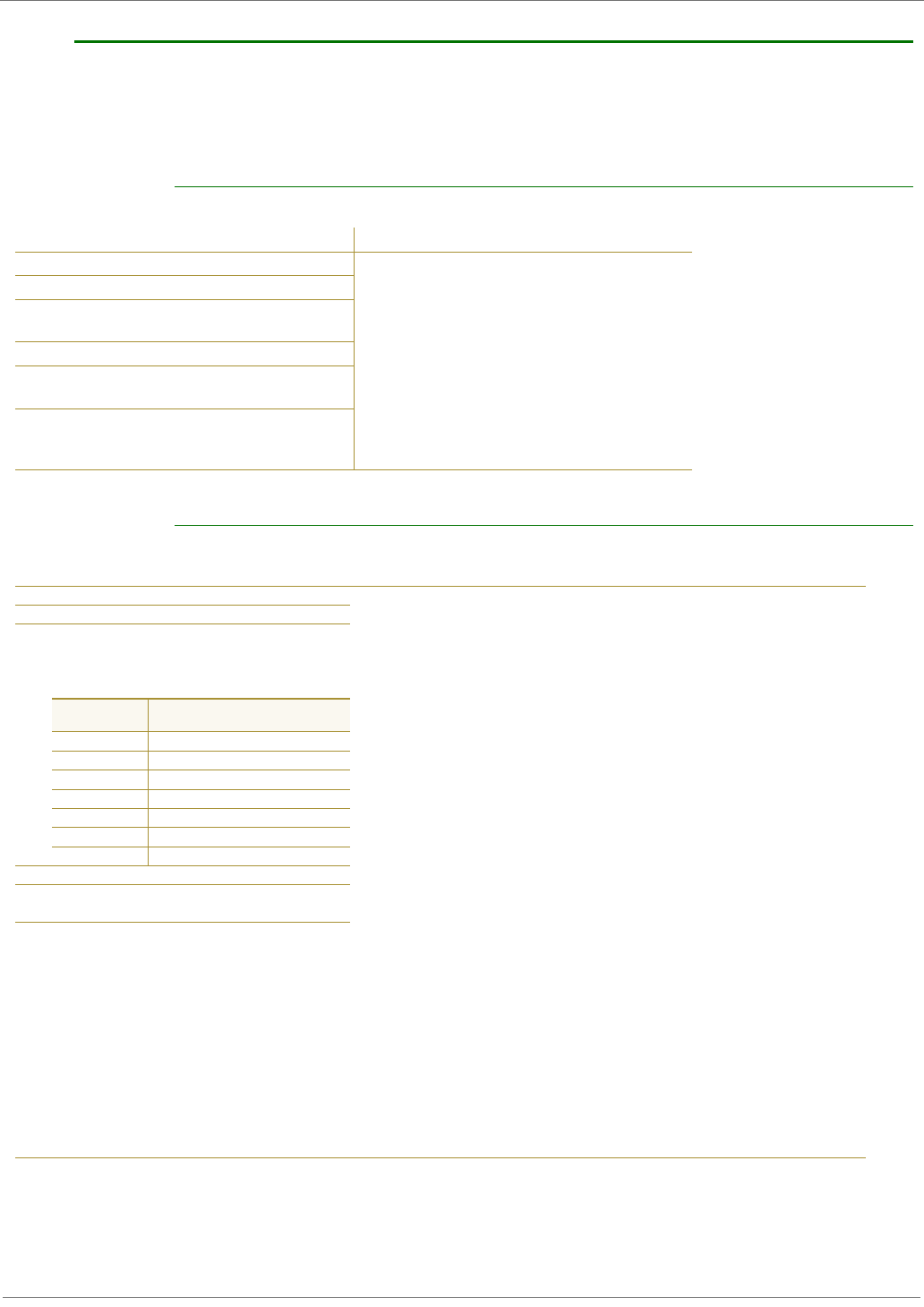
XBee‐PRO™XSCOEMRFModules
©2008DigiInternational,Inc. 21
PreliminaryDraft
3.3. Command Descriptions
Commands in this section are listed alphabetically. Command categories are designated between
the “< >” symbols that follow each command title. Modules expect numerical values in
hexadecimal and those values are designated by a “0x” prefix.
Modules operating within the same network should contain the same firmware version.
AT (Guard Time After) Command
BD (Interface Data Rate) Command
Command Summary Description
AT Command: ATAT <Command Mode Options> AT
Command is used to set the time-of-
silence that follows the command
sequence character (CC Command). By
default, AT Command Mode will activate
after one second of silence.
Refer to the AT Commands section [p] to
view the default AT Command Mode
Sequence.
Binary Command: 0x05 (5 decimal)
Parameter Range:0x02 – 0xFFFF
[x 100 milliseconds]
Number of bytes returned: 2
Default Parameter Value: 0x0A (10
decimal)
Related Commands: BT (Guard Time
Before), CC (Command Sequence
Character)
Command Summary Description
AT Command: ATBD <Serial Interfacing> BD Command allows the user to adjust the
UART interface data rate and thus modify the rate at which
serial data is sent to the module. The new baud rate does not
take effect until the CN (Exit AT Command Mode) Command is
issued. The RF data rate is not affected by the BD Command.
Although most applications will only require one of the seven
standard baud rates, non-standard baud rates are also
supported.
Note: If the serial data rate is set to exceed the fixed RF data
rate of the module, flow control may need to be implemented
as described in the Pin Signals and Flow Control sections of this
manual.
Non-standard Interface Data Rates: When parameter values
outside the range of standard baud rates are sent, the closest
interface data rate represented by the number is stored in the
BD register. For example, a rate of 19200 bps can be set by
sending the following command line "ATBD4B00". NOTE: When
using X-CTU Software, non-standard interface data rates can
only be set and read using the X-CTU ‘Terminal’ tab. Non-
standard rates are not accessible through the ‘Modem
Configuration’ tab.
When the BD command is sent with a non-standard interface
data rate, the UART will adjust to accommodate the requested
interface rate. In most cases, the clock resolution will cause the
stored BD parameter to vary from the parameter that was sent
(refer to the table below). Reading the BD command (send
"ATBD" command without an associated parameter value) will
return the value that was actually stored to the BD register.
Binary Command: 0x15 (21 decimal)
Parameter Range (Standard baud rates):
0 – 6
(Non-standard baud rates): 0x7D –
0xFFFF (125d – 65535d)
Parameter
Value
BAUD (bps)
Configuration
0 1200
1 2400
2 4800
3 9600
4 19200
5 38400
6 57600
Number of bytes returned: 2
Default Parameter Value: Set to equal
module’s factory-set RF data rate.
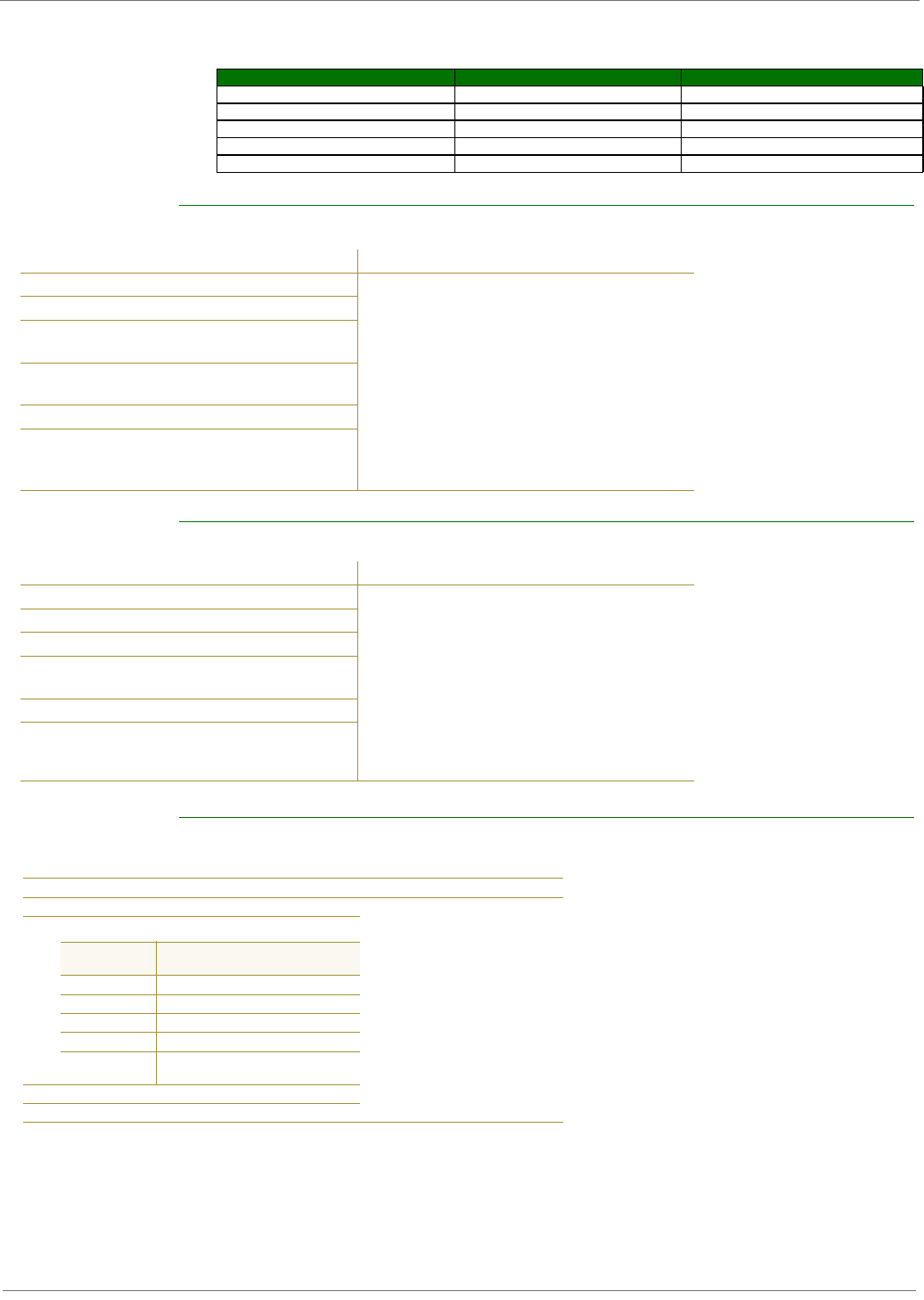
XBee‐PRO™XSCOEMRFModules
©2008DigiInternational,Inc. 22
PreliminaryDraft
Table3‐02. ParameterSentvs.ParameterStored
BT (Guard Time Before) Command
CC (Command Sequence Character) Command
CD (DO3 Configuration) Command
BD Parameter Sent (HEX) Interface Data Rate (bps) BD Parameter Stored (HEX)
0 1200 0
4 19,200 4
6 57600 6
12C 300 12B
E100 57600 E883
Command Summary Description
AT Command: ATBT <Command Mode Options> BT
Command is used to set the DI pin
silence time that must precede the
command sequence character (CC
Command) of the AT Command Mode
Sequence. Refer to the AT Commands
section [p] to view the default AT
Command Mode Sequence.
Binary Command: 0x04 (4 decimal)
Parameter Range:2 – 0xFFFF
[x 100 milliseconds]
Default Parameter Value: 0x0A (10
decimal)
Number of bytes returned: 2
Related Commands: AT (Guard Time
After), CC (Command Sequence
Character)
Command Summary Description
AT Command: ATCC <Command Mode Options> CC
Command is used to set the ASCII
character to be used between Guard
Times of the AT Command Mode
Sequence (BT+ CC + AT). The AT
Command Mode Sequence activates AT
Command Mode (from Idle Mode).
Refer to the AT Commands section [p] to
view the default AT Command Mode
Sequence.
Binary Command: 0x13 (19 decimal)
Parameter Range: 0x20 – 0x7F
Default Parameter Value: 0x2B (ASCII “+”
sign)
Number of bytes returned: 1
Related Commands: AT (Guard Time
After), BT (Guard Time Before)
Description
AT Command: ATCD
Binary Command: 0x28 (40 decimal) <Command Mode
Options> CD
Command is used to
define the behavior of
the DO3/RX LED line.
Parameter Range: 0 – 3
Parameter
Value Configuration
0RX LED
1Default high
2Default low
3 (reserved)
4Assert only when packet
addressed to module is sent
Default Parameter Value: 0
Number of bytes returned: 1

XBee‐PRO™XSCOEMRFModules
©2008DigiInternational,Inc. 23
PreliminaryDraft
CN (Exit AT Command Mode) Command
CS (DO2 Configuration) Command
CT (Command Mode Timeout) Command
DB (RSSI in dBm) Command
Command Summary Description
AT Command: ATCN <Command Mode Options> CN
Command is used to explicitly exit AT
Command Mode.
Binary Command: 0x09 (9 decimal)
Command Summary Description
AT Command: ATCS <Serial Interfacing> CS
Command is used to
select the behavior of
the DO2 pin signal.
This output can
provide RS-232 flow
control, control the TX
enable signal (for RS-
485 or RS-422
operations), or set the
default level for the I/O
line passing function.
By default, DO2
provides RS-232 CTS
(Clear-to-Send) flow
control.
Binary Command: 0x1F (31 decimal)
Parameter Range:0 – 4
Parameter
Value Configuration
0RS-232 flow control
1 RS-485 TX enable low
2high
3 RS-485 TX enable high
4low
Default Parameter Value: 0
Number of bytes returned: 1
Minimum Firmware Version Required:
4.27D
Command Summary Description
AT Command: ATCT <Command Mode Options> CT
Command sets the amount of time
before AT Command Mode terminates
automatically. After a CT time of
inactivity, the module exits AT
Command Mode and returns to Idle
Mode. AT Command Mode can also be
exited manually using CN (Exit AT
Command Mode) Command.
Binary Command: 0x06 (6 decimal)
Parameter Range:0x02 – 0xFFFF
[x 100 milliseconds]
Default Parameter Value: 0xC8 (200
decimal, 20 seconds)
Number of bytes returned: 2
Command Summary Description
AT Command: ATDB <Diagnostics> DB command returns the
signal level of the last packet received in
dBm. This reading is useful for
determining range characteristics of the
Modules under various conditions of
noise and distance.
Once the command is issued, the
module will return the value in dBm.
0x32 (50d) = -50 dBm (strong signal),
and 0x64 (100d) = -100 dBm (weak
signal).
Binary Command: Not available
Parameter Range:00x00 to 0x70
[read-only]
Number of bytes returned: returned: 1
Related Commands: RS (RSSI Level)
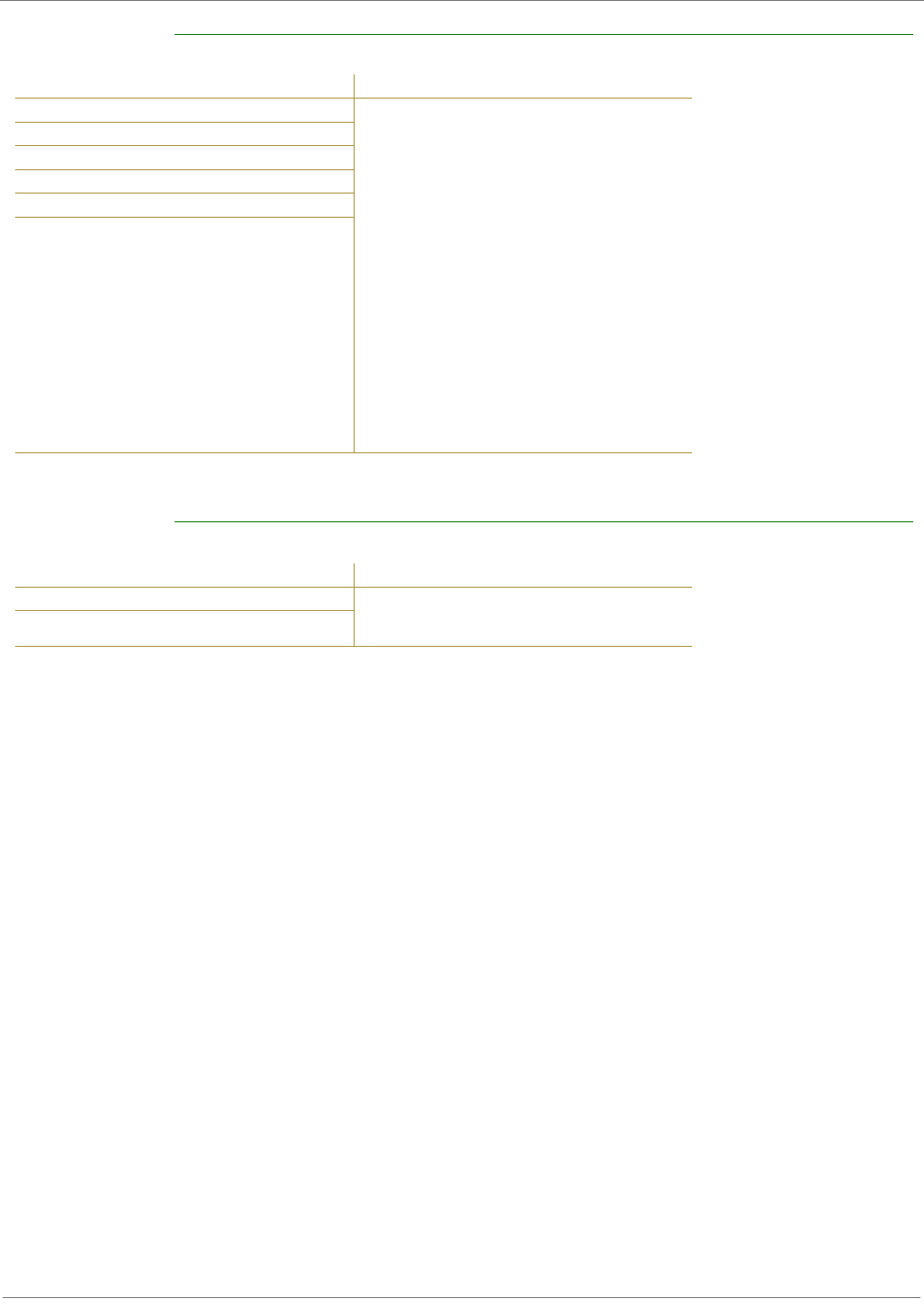
XBee‐PRO™XSCOEMRFModules
©2008DigiInternational,Inc. 24
PreliminaryDraft
DT (Destination Address) Command
E0 (Echo Off) Command
Command Summary Description
AT Command: ATDT <Networking> DT Command is used to
set the networking address of a Module.
Modules use three network layers –
Vendor Identification Number (ATID),
Channels (ATHP), and Destination
Addresses (ATDT). DT Command
assigns an address to a module that
enables it to communicate only with
other modules having the same
addresses. All modules that share the
same Destination Address can
communicate freely with each other.
Modules in the same network with a
different Destination Address (than that
of the transmitter) will listen to all
transmissions to stay synchronized, but
will not send any of the data out their
serial ports.
Binary Command: 0x00
Parameter Range:0 – 0xFFFF
Default Parameter Value: 0
Number of bytes returned: 2
Related Commands: HP (Hopping
Channel), ID (Module VID), MK (Address
Mask)
Command Summary Description
AT Command: ATE0 <Command Mode Options> E0
Command turns off character echo in AT
Command Mode. By default, echo is off.
Binary Command: 0x0A (10 decimal)
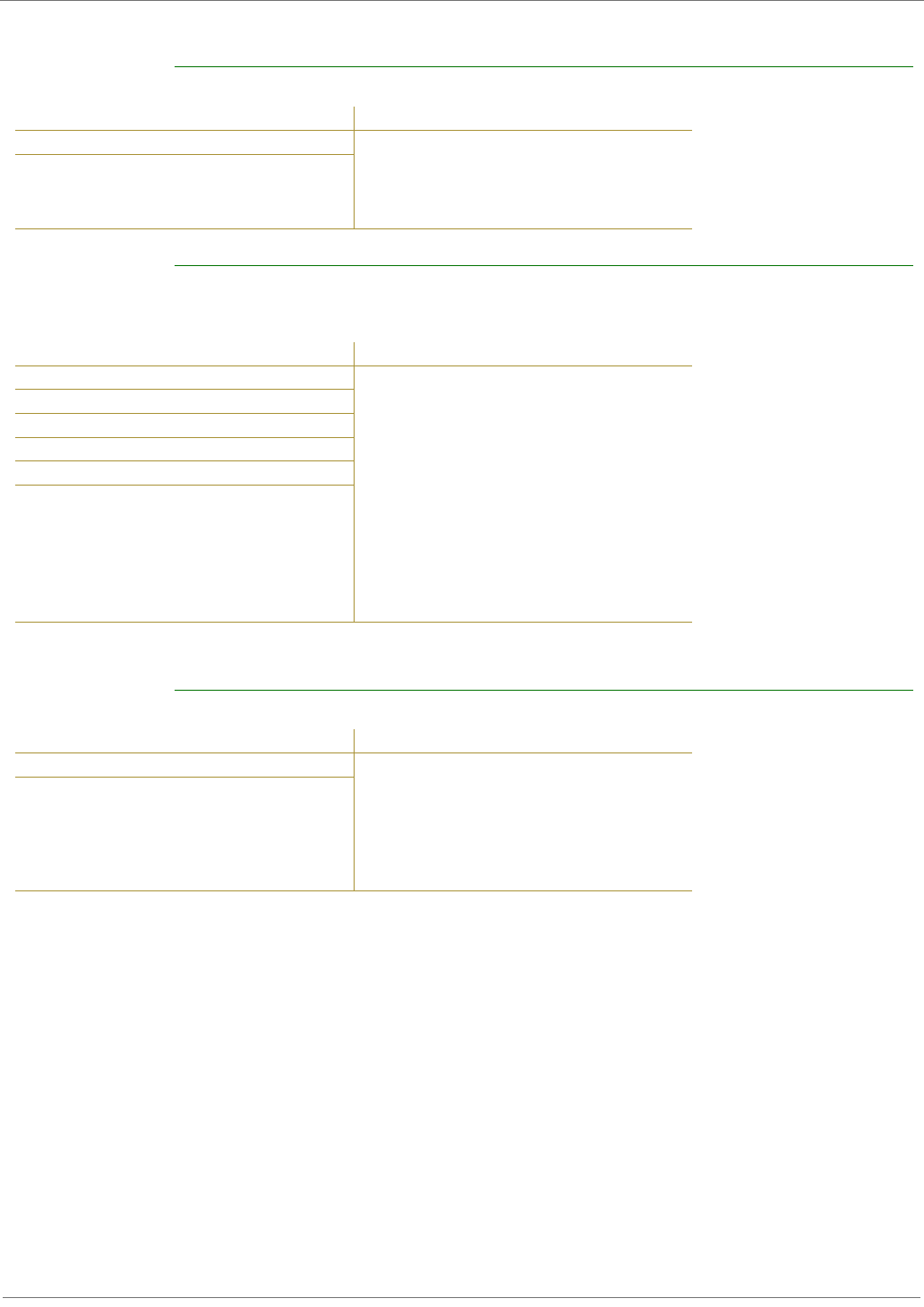
XBee‐PRO™XSCOEMRFModules
©2008DigiInternational,Inc. 25
PreliminaryDraft
E1 (Echo On) Command
ER (Receive Error Count) Command
FH (Force Wake-up Initializer) Command
Command Summary Description
AT Command: ATE1 <Command Mode Options> E1
Command turns on the echo in AT
Command Mode. Each typed character
will be echoed back to the terminal
when ATE1 is active. E0 is the default.
Binary Command: 0x0B (11 decimal)
Command Summary Description
AT Command: ATER <Diagnostics> Set/Read the receive-
error. The error-count records the
number of packets partially received
then aborted on a reception error. This
value returns to 0 after a reset and is not
non-volatile (Value does not persist in
the module’s memory after a power-up
sequence). Once the “Receive Error
Count” reaches its maximum value (up
to 0xFFFF), it remains at its maximum
count value until the maximum count
value is explicitly changed or the
module is reset.
Binary Command: 0x0F (15 decimal)
Parameter Range:0 – 0xFFFF
Default Parameter Value: 0
Number of bytes returned: 2
Related Commands: GD (Receive Good
Count)
Command Summary Description
AT Command: ATFH <Sleep (Low Power)> FH Command is
used to force a Wake-up Initializer to be
sent on the next transmit. WR (Write)
Command does not need to be issued
with FH Command.
Use only with cyclic sleep modes active
on remote modules.
Binary Command: 0x0D (13 decimal)
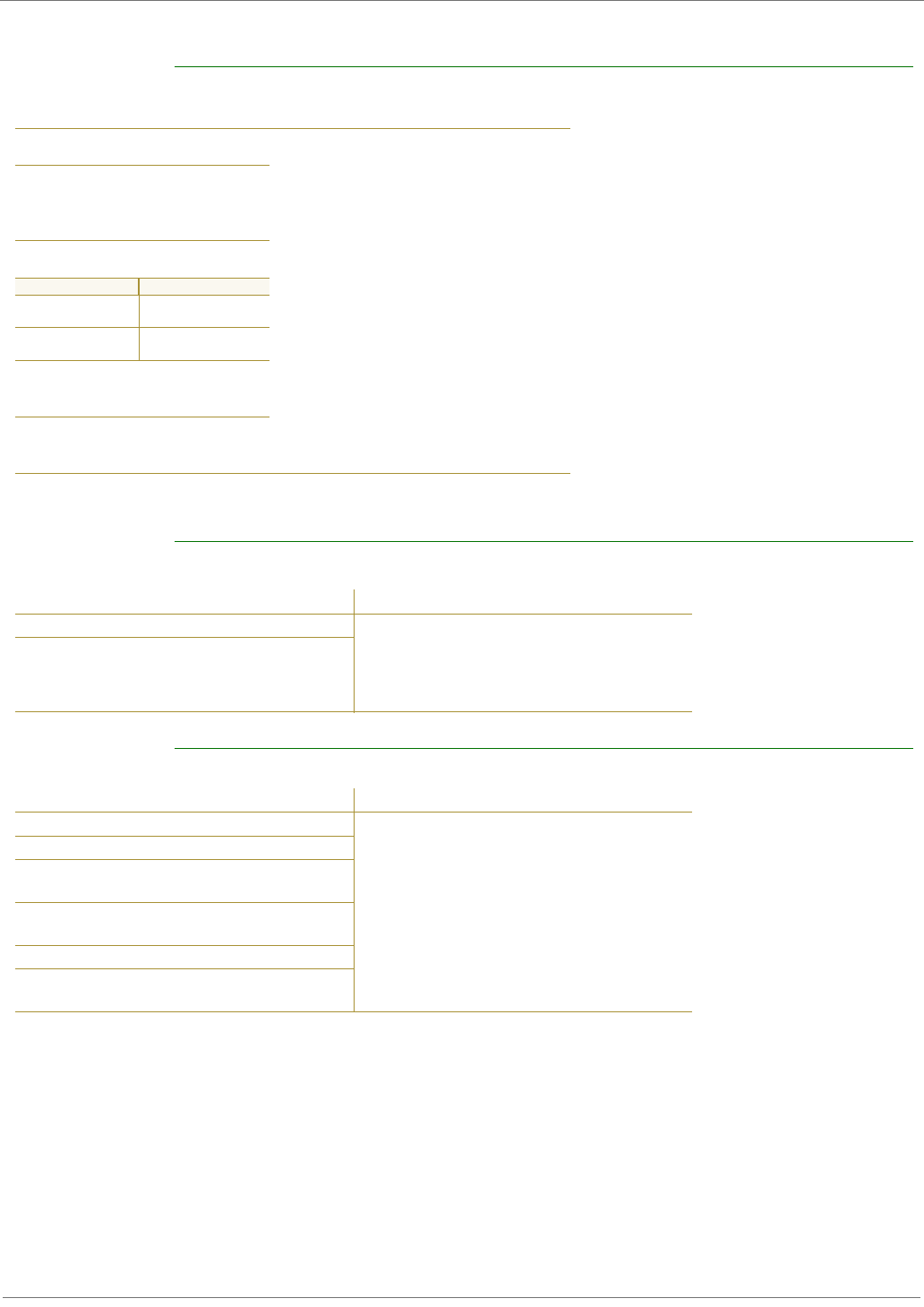
XBee‐PRO™XSCOEMRFModules
©2008DigiInternational,Inc. 26
PreliminaryDraft
FL (Software Flow Control) Command
FR (Force Reset) Command
FT (Flow Control Threshold) Command
Command Summary Description
AT Command:
ATFL
<Serial Interfacing> FL Command
is used to configure software flow
control. Hardware flow control is
implemented with the Module as
the DO2 pin (), which regulates
when serial data can be transferred
to the module. FL Command can be
used to allow software flow control
to also be enabled. XON character
used is 0x11 (17 decimal). XOFF
character used is 0x13 (19
decimal).
Binary
Command:
0x07 (7
decimal)
Parameter
Range: 0 – 1
Parameter Value Configuration
0Disable software
flow control
1Enable software
flow control
Default
Parameter
Value: 0
Number of
bytes
returned: 1
Command Summary Description
AT Command: ATFR <Special> FR command is used in order
to reset the module through the UART.
The characters “OK”<CR> will be
returned and the module will reset
100ms
Binary Command: Not available
Command Summary Description
AT Command: ATFT <Serial Interfacing> Set/Read the flow
control threshold. When FT bytes have
accumulated in the
DI buffer, CTS is de-asserted or the XOFF
software flow control character is
transmitted.
Binary Command: 0x24 (36 decimal)
Parameter Range:0 – (DI buffer size minus
0x11 bytes)
Default Parameter Value: DI Buffer size
minus 0x11 (17 decimal)
Number of bytes returned: 2
Minimum Firmware Version Required:
4.27B
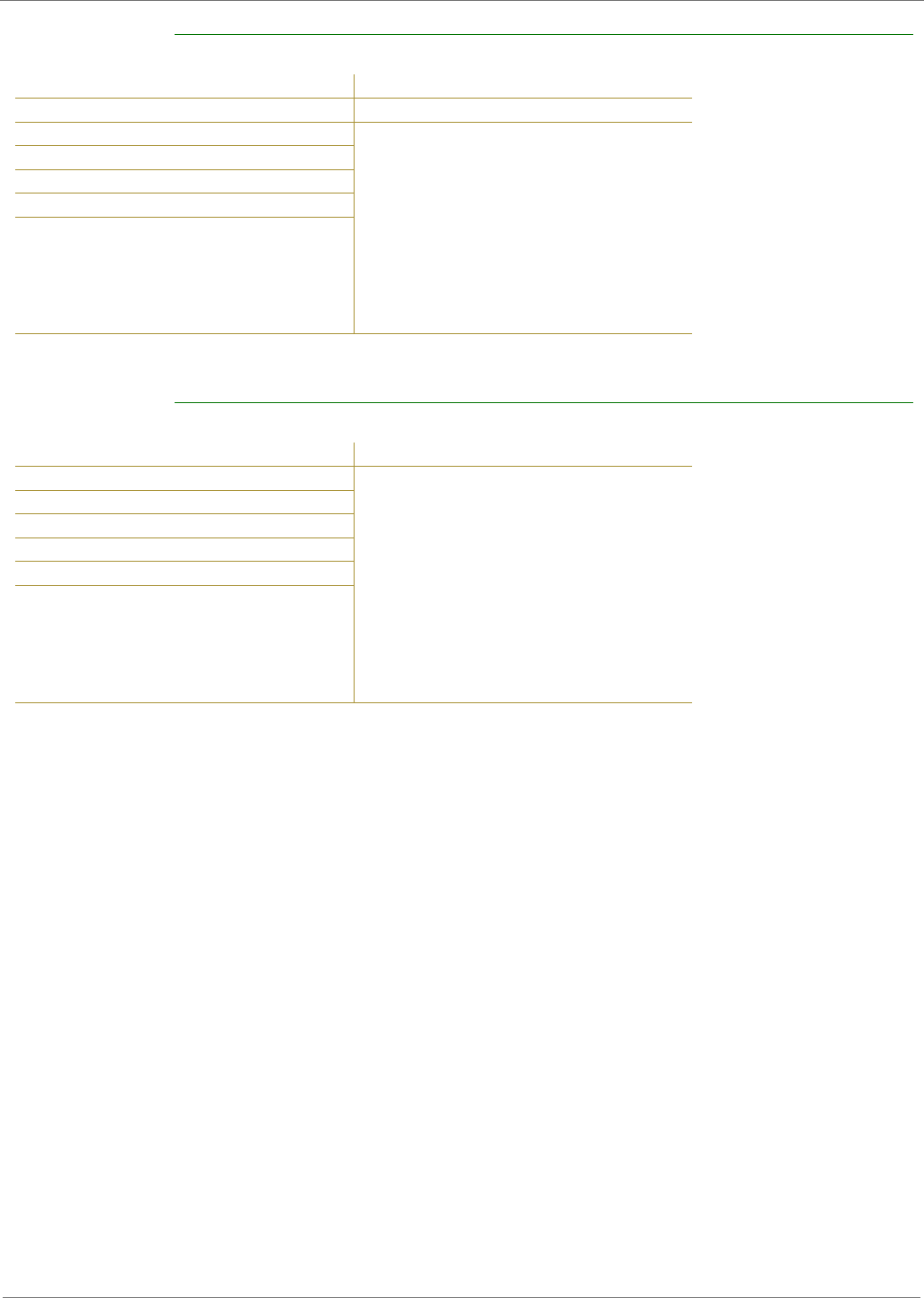
XBee‐PRO™XSCOEMRFModules
©2008DigiInternational,Inc. 27
PreliminaryDraft
GD (Receive Good Count) Command
HP (Hopping Channel) Command
Command Summary Description
AT Command: ATGD
Binary Command: 0x10 (16 decimal) <Diagnostics> Set/Read the count of
good received RF packets. Parameter
value is reset to 0 after every reset and is
not non-volatile (Value does not
persist in the module’s memory after a
power-up sequence). Once the
“Receive Good Count” reaches its
maximum value (up to 0xFFFF), it
remains at its maximum count value until
the maximum count value is
manually changed or the module is reset.
Parameter Range:0 – 0xFFFF
Default Parameter Value: 0
Number of bytes returned: 2
Related Commands: ER (Receive Error
Count)
Command Summary Description
AT Command: ATHP <Networking> HP Command is used to
set the module’s hopping channel
number. A channel is one of three layers
of addressing available to the
module. In order for modules to
communicate with each other, the
modules must have the same channel
number since each network uses a
different hopping sequence. Different
channels can be used to prevent
modules in one network from listening
to transmissions of another.
Binary Command: 0x11 (17 decimal)
Parameter Range:0 – 6
Default Parameter Value: 0
Number of bytes returned: 1
Related Commands: DT (Destination
Address), ID (Module VID), MK (Address
Mask)
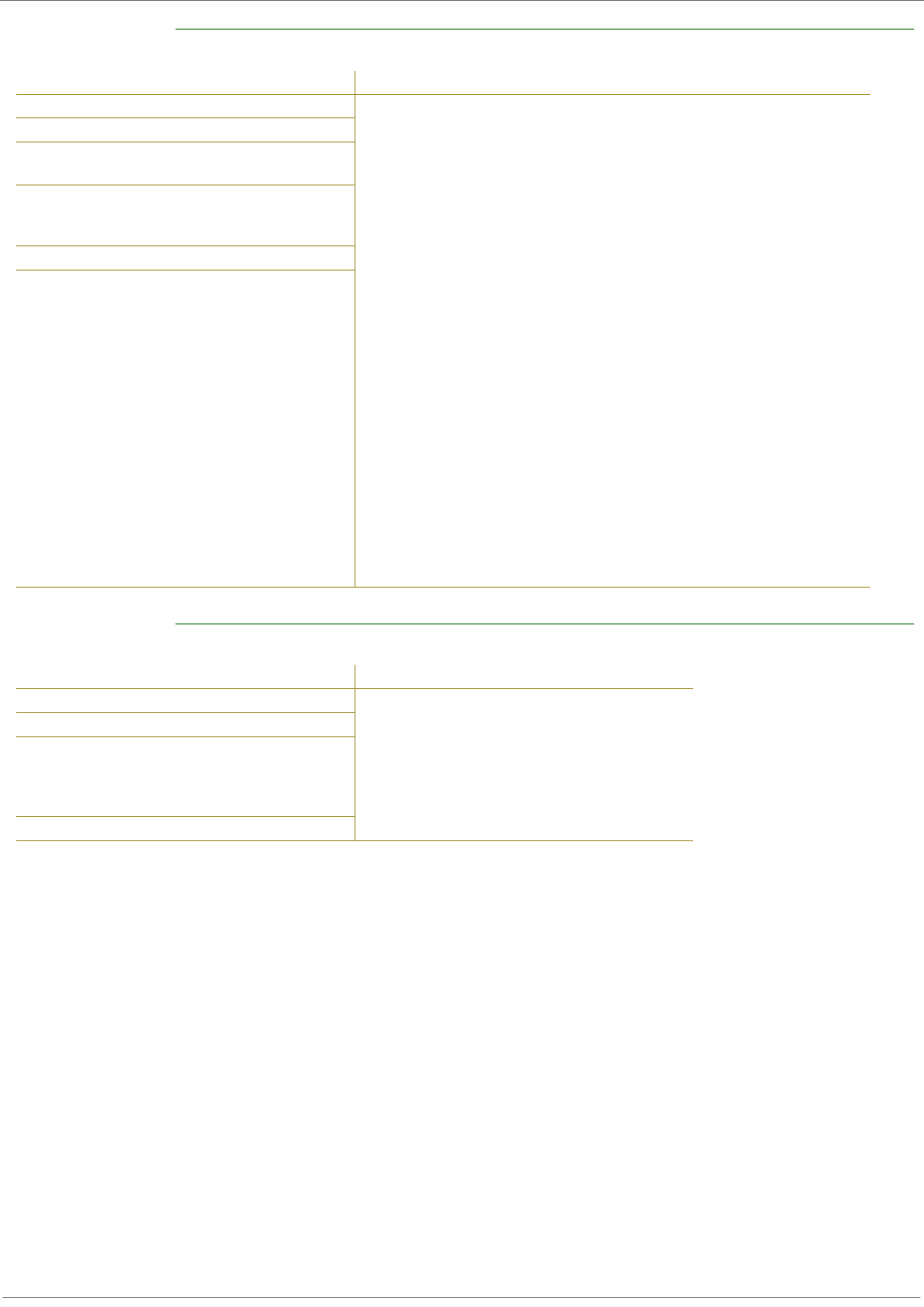
XBee‐PRO™XSCOEMRFModules
©2008DigiInternational,Inc. 28
PreliminaryDraft
HT (Time before Wake-up Initializer) Command
ID (Modem VID) Command
Command Summary Description
AT Command: ATHT <Sleep (Low Power)> If any modules within range are running
in a “CyclicSleep” setting, a wake-up initializer must be used by
the transmitting module for sleeping modules to remain awake
[refer to the LH (“Wake-up InitializerTimer”) Command]. When a
receiving module in Cyclic Sleep wakes, it must detect the
wake-up initializer in order to remain awake and
receive data. The value of HT Parameter tells the transmitter,
“After a period of inactivity (no transmitting or receiving)
lasting HT amount of time, send a long wake-up initializer”. HT
Parameter should be set to match the inactivity timeout
[specified by ST (Time before Sleep) Command]
used by the receiver(s). From the receiving module perspective,
after HT time elapses and the inactivity
timeout [ST Command] is met, the receiver goes into cyclic
sleep. In cyclic sleep, the receiver wakes once per sleep interval
to check for a wakeup initializer. When a wake-up initializer is
detected, the module will stay awake to receive data. The
wake-up initializer must be longer than the
cyclic sleep interval to ensure that sleeping modules detect
incoming data. When HT time elapses, the transmitter then
knows that it needs to send a long Wake-up Initializer for all
receivers to be able to remain awake and
receive the next transmission. Matching HT to the time
specified by ST on the receiving module guarantees that all
receivers will detect the next transmission.
Binary Command: 0x03 (3 decimal)
Parameter Range:0 – 0xFFFF
[x 100 milliseconds]
Default Parameter Value: 0xFFFF (means
that long wake-up initializer will not be
sent)
Number of bytes returned: 2
Related Commands: LH (Wake-up
Initializer Timer), SM (Sleep Mode), ST
(Time before Sleep)
Command Summary Description
AT Command: ATID <Networking> Set/Read the “Vendor
Identification Number”. Only modems
with matching IDs can communicate
with each other. Modules with
nonmatching
VIDs will not receive unintended data
transmission.
Binary Command: 0x27 (39 decimal)
Parameter Range (user-settable):
0x10 - 0x7FFFF
(Factory-set and read-only):0x8000 –
0xFFFF
Number of bytes returned: 2

XBee‐PRO™XSCOEMRFModules
©2008DigiInternational,Inc. 29
PreliminaryDraft
LH (Wake-up Initializer Timer) Command
MK (Address Mask) Command
Command Summary Description
AT Command: ATLH <Sleep (Low Power)> LH Command
adjusts the duration of time for which
the RF initializer is sent.
When receiving modules are put into
Cyclic Sleep Mode, they power-down
after a period of inactivity [specified by
ST (Time before Sleep) Command] and
will periodically awaken and listen
for transmitted data. In order for the
receiving modules to remain awake, they
must detect~35ms of the wake-up
initializer. LH Command must be used
whenever a receiver is operating in
Cyclic Sleep Mode. This lengthens
the Wake-up Initializer to a specific
amount of time (in tenths of a second).
The Wake-up Initializer Time must be
longer than the cyclic sleep time that is
determined by SM (Sleep Mode)
Command. If the wake-up initializer
time were less than the Cyclic Sleep
interval, the connection would be at risk
of missing the wake-up initializer
transmission. Refer to Figures 3.1 & 3.2
of the SM Command description to view
diagrams of correct and incorrect
configurations. The images help
visualize the importance that the value
of LH be greater than the value of SM.
Binary Command: 0x0C (12 decimal)
Parameter Range:0 – 0xFF
[x 100 milliseconds]
Default Parameter Value: 1
Number of bytes returned: 1
Related Commands: HT (Time before
Wake-up Initializer), SM (Sleep Mode), ST
(Time before Sleep)
Command Summary Description
AT Command: ATMK <Networking> MK Command is used to
set/read the Address Mask.
All data packets contain the Destination
Address of the transmitting module.
When an RF data packet is received, the
transmitter’s Destination Address is
logically “ANDed” (bitwise) with the
Address Mask of the receiver. The
resulting value must match the
Destination Address or the
Address Mask of the receiver for the
packet to be received and sent out the
module’s DO serial port. If the “ANDed”
value does not match either the
Destination Address or the Address
Mask of the receiver, the packet is
discarded. (All “0” values are treated as
“irrelevant” values and are ignored.)
Binary Command: 0x12 (18 decimal)
Parameter Range:0 – 0xFFFF
Default Parameter Value: 0xFFFF
(Destination address (DT parameter) of
the transmitting module must exactly
match the destination address of the
receiving module.)
Number of bytes returned: 2
Related Commands: DT (Destination
Address), HP (Hopping Channel), ID
(Module VID), MY (Source Address)
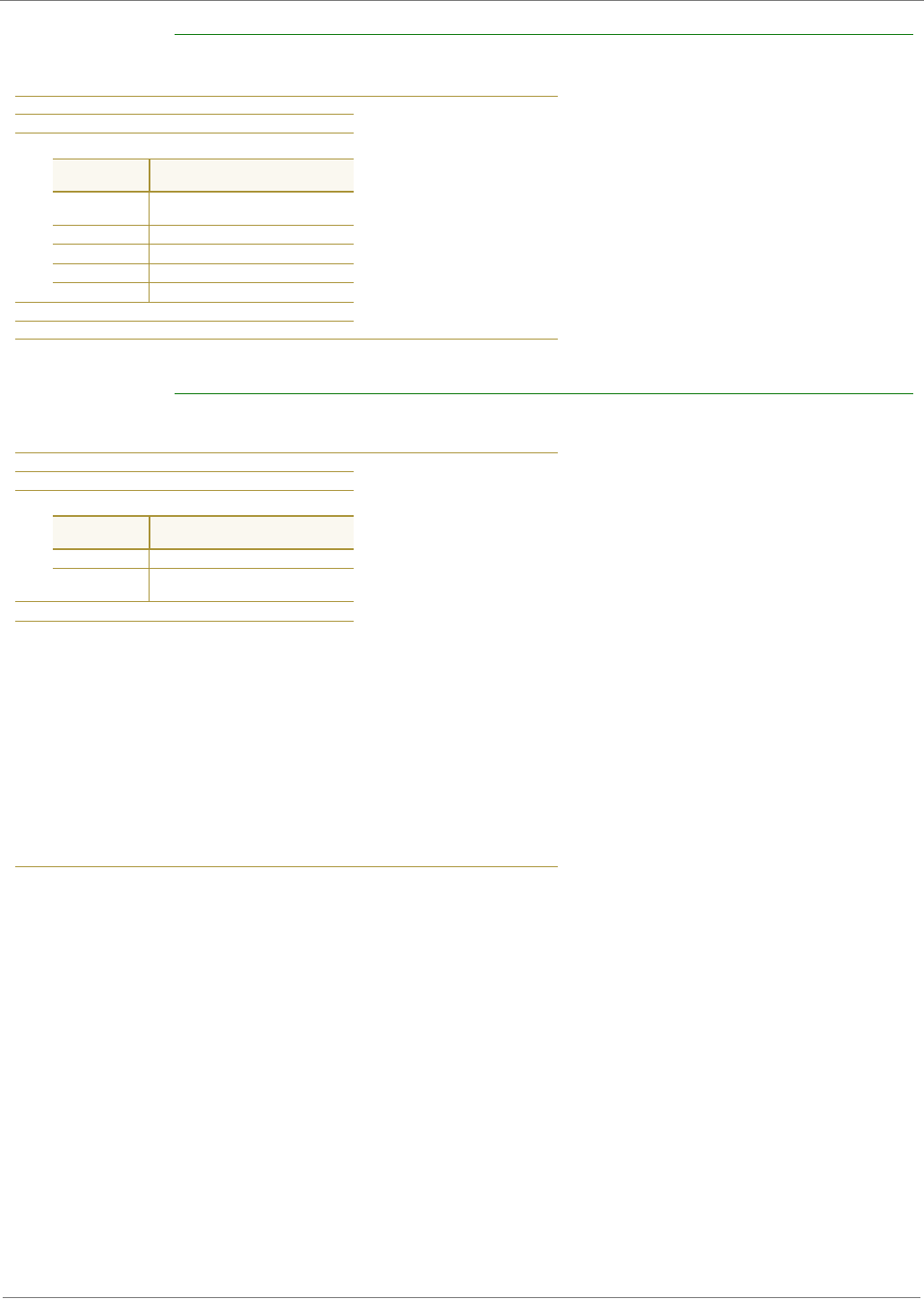
XBee‐PRO™XSCOEMRFModules
©2008DigiInternational,Inc. 30
PreliminaryDraft
NB (Parity) Command
PC (Power-up to AT Mode) Command
Command Summary Description
AT Command: ATNB <Serial Interfacing>
Select/Read parity
settings for UART
communications.
Binary Command: 0x23 (35 decimal)
Parameter Range:0 – 4
Parameter
Value Configuration
08-bit (no parity or
7-bit (any parity)
18-bit even
28-bit odd
38-bit mark
48-bit space
Default Parameter Value: 0
Number of bytes returned: 1
Command Summary Description
AT Command: ATPC <Command Mode
Options> PC
Command allows the
module to power-up
directly into AT
Command Mode from
reset or power-on. If
PC Command is
enabled with SM
Parameter set to 1, DI3
(pin 2) can be used to
enter the
module into AT
Command Mode. When
the DI3 pin is de-
asserted (low),
the module will wake-
up in AT Command
Mode. This behavior
allows module
DTR emulation.
Binary Command: 0x1E (30 decimal)
Parameter Range:0 – 1
Parameter
Value Configuration
0 Power-up to Idle Mode
1Power-up to
AT Command Mode
Default Parameter Value: 0
Number of bytes returned: 1

XBee‐PRO™XSCOEMRFModules
©2008DigiInternational,Inc. 31
PreliminaryDraft
PW (Pin Wake-up) Command
RE (Restore Defaults) Command
RN (Delay Slots) Command
Command Summary Description
AT Command: ATPW <Sleep (Low Power)> Under normal operation, a module in
Cyclic Sleep Mode cycles from an active state to a low-power
state at regular intervals until data is ready to be received. If
the PW Parameter is set to 1, SLEEP (pin 2) can be used to wake
the module from Cyclic Sleep. If the SLEEP pin
is de-asserted (low), the module will be fully operational and
will not go into Cyclic Sleep. Once SLEEP is asserted, the
module will remain active for the period of time specified by ST
(Time before Sleep) Command, and will return to Cyclic Sleep
Mode (if no data is ready to be transmitted). PW
Command is only valid if Cyclic Sleep has been enabled.
Binary Command: 0x1D (29 decimal)
Parameter Range:0 – 1
Parameter
Value Configuration
0 Disabled
1Enabled
Default Parameter Value: 0
Number of bytes returned: 1
Related Commands: SM (Sleep Mode), ST
(Time before Sleep)
Minimum Firmware Version Required:
4.22
Command Summary Description
AT Command: ATRE <Diagnostics> RE Command restores all
configurable parameters to factory
default settings. However, RE Command
will not write the default values to
non-volatile (persistent) memory. Unless
the WR (Write) Command is
issued after the RE command, the
default settings will not be saved in the
event of module reset or power-down.
Binary Command: 0x0E (14 decimal)
Command Summary Description
AT Command: ATRN <Networking> RN Command is only
applicable if retries have been
enabled [RR (Retries) Command], or if
forced delays will be inserted into
a transmission [refer to TT (Streaming
Limit) Command]. RN Command is
used to adjust the time delay that the
transmitter inserts before attempting
to resend a packet. If the transmitter
fails to receive an acknowledgement
after sending a packet, it will insert a
random number of delay slots
(ranging from 0 to (RN minus 1)) before
attempting to resend the packet.
Each delay slot lasts for a period of
38ms.
If two modules attempted to transmit at
the same time, the random time
delay after packet failure would allow
one of the two modules to transmit
the packet successfully, while the other
would wait until the channel
opens up to begin transmission.
Binary Command: 0x19 (25 decimal)
Parameter Range:0 – 0xFF [slots]
Default Parameter Value: 0 (no delay slots
inserted)
Number of bytes returned: 1
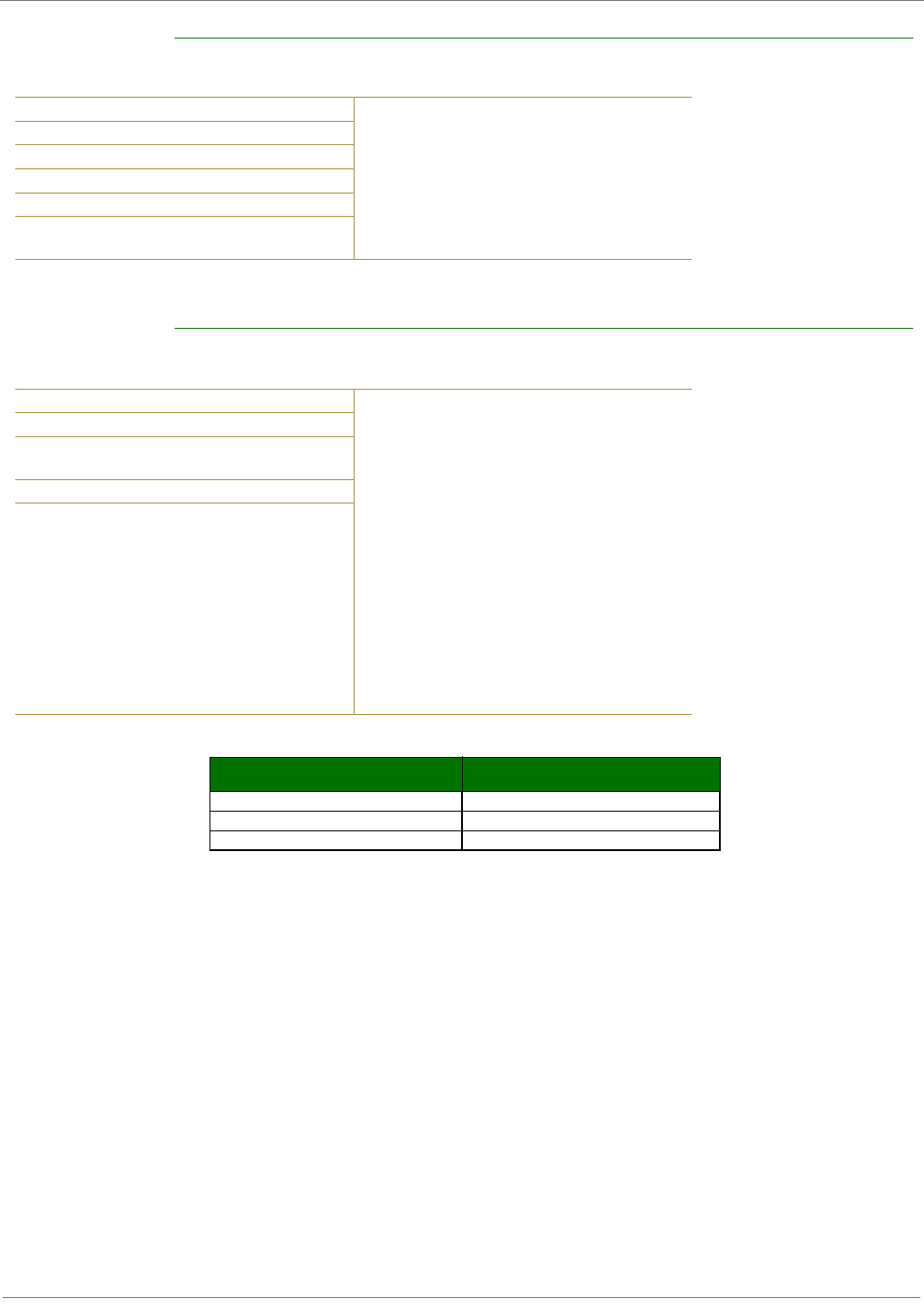
XBee‐PRO™XSCOEMRFModules
©2008DigiInternational,Inc. 32
PreliminaryDraft
RO (Packetization Timeout) Command
.
RP (RSSI PWM Timer) Command
Tab le3‐03. PWMChart
A non-zero value defines the time that the PWM output will be active with the RSSI value of the
last received RF packet. After the set time when no RF packets are received, the PWM output will
be set low (0 percent PWM) until another RF packet is received. The PWM output will also be set
low at power-up. A parameter value of 0xFF permanently enables the PWM output and it will
always reflect the value of the last received RF packet.
PWM output shares the Config input pin. When the module is powered, the Config pin will be an
input. During the power-up sequence, the Config pin will be read to determine whether the module
is going into AT Command Mode. After this, if RP parameter is a non-zero value, the Config pin will
be configured as an output and set low until the first RF packet is received. With a non-zero RP
parameter, the Config pin will be an input for RP ms after power up.
Command Summary Description
AT Command: ATRO <Serial Interfacing> RO Command is used
to specify/read the time of
silence (no bytes received) after which
transmission begins. After a serial
byte is received and if no other byte is
received before the RO timeout,
the transmission will start.
Binary Command: 0x21 (33 decimal)
Parameter Range:0 – 0xFFFF [x 200 µs]
Default Parameter Value: 0
Number of bytes returned: 2
Minimum Firmware Version Required:
4.2AA
Command Summary Description
AT Command: ATRP <Diagnostics> RP Command is used to
enable a PWM (“Pulse Width Modulation”)
output on the Config pin which is
calibrated to show the level the
received RF signal is above the sensitivity
level of the module. The PWM
pulses vary from zero to 95 percent. Zero
percent means the received RF
signal is at or below the published
sensitivity level of the module. The
following
table shows levels above sensitivity and
PWM values.
The total period of the PWM output is
8.32 ms. There are 40 steps in the
PWM output and therefore the minimum
step size is 0.208 ms.
Binary Command: 0x22 (34 decimal)
Parameter Range:0 - 0x7F
[x 100 milliseconds]
Default Parameter Value: 0 (disabled)
Number of bytes returned: 1
dBm above Sensitivity PWM percentage
(high period / total period)
10 47.5 %
20 62.5 %
30 77.5 %

XBee‐PRO™XSCOEMRFModules
©2008DigiInternational,Inc. 33
PreliminaryDraft
RR (Retries) Command
RS (RSSI) Command
Command Summary Description
AT Command: ATRR Networking> RR Command specifies the
number of retries that can be sent
for a given RF packet. Once RR Command
is enabled (set to a non-zero
value), RF packet acknowledgements and
retries are enabled. After transmitting
a packet, the transmitter will wait to
receive an acknowledgement
from a receiver. If the acknowledgement
is not received in the period of
time specified by the RN (Delay Slots)
Command, the transmitter will transmit
the original packet again. The packet will
be transmitted repeatedly
until an acknowledgement is received or
until the packet has been sent RR
times.
Note: For retries to work correctly, all
modules in the system must have
retries enabled.
Binary Command: 0x18 (24 decimal)
Parameter Range:0 – 0xFF
Default Parameter Value: 0 (disabled)
Number of bytes returned: 1
Command Summary Description
AT Command: ATRS <Diagnostics> RS Command returns the
signal level of the last packet
received. This reading is useful for
determining range characteristics of the
modules under various conditions of
noise and distance.
Once the command is issued, the
module will return a value between 0x6
and 0x36 where 0x36 represents a very
strong signal level and 0x4 indicates
a low signal level.
Binary Command: 0x1C (28 decimal)
Parameter Range: 0x06 – 0x36 [read-
only]
Number of bytes returned: 1

XBee‐PRO™XSCOEMRFModules
©2008DigiInternational,Inc. 34
PreliminaryDraft
RT (DI2 Configuration) Command
SB (Stop Bits) Command
SH (Serial Number High) Command
SL (Serial Number Low) Command
Command Summary Description
AT Command: ATRT <Serial Interfacing> RT
command is used to
dictate the behavior of
the
DI2/RTS/CMD line. RT
Command must be
issued to enable RTS
flow control
or binary
programming.
Binary Command: 0x16 (22 decimal)
Parameter Range:0 – 2
Parameter
Value Configuration
0 disabled
1 Enable Binary Programming
2Enable Flow Control
Default Parameter Value: 0
Number of bytes returned: 1
Command Summary Description
AT Command: ATSB SB Command is used to
set/read the number of
stop bits in the data
packets.
Binary Command: 0x36 (54 decimal)
Parameter Range:0 – 1
Parameter
Value Configuration
01 stop bits
12 stop bits
Default Parameter Value: 0
Number of bytes returned: 1
Command Summary Description
AT Command: ATSH <Diagnostics> Set/Read the serial
number high word of the module.
Binary Command: 0x25 (37 decimal)
Parameter Range:0 – 0xFFFF [read-only]
Number of bytes returned: 2
Related Commands: SL (Serial Number
Low)
Command Summary Description
AT Command: ATSH <Diagnostics> Set/Read the serial
number low word of the module.
Binary Command: 0x26 (38 decimal)
Parameter Range:0 – 0xFFFF [read-only]
Number of bytes returned: 2
Related Commands: SH (Serial Number
High)
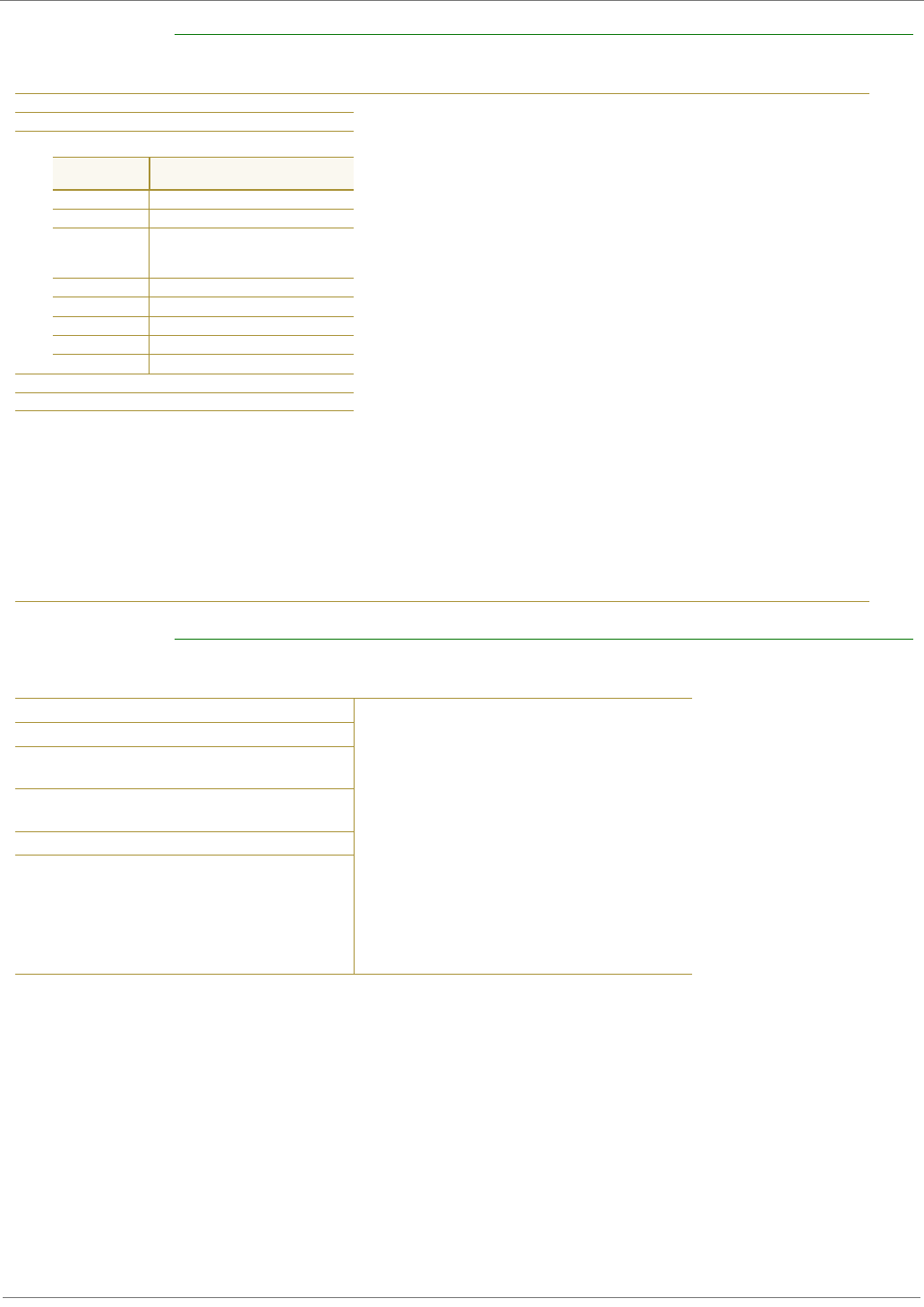
XBee‐PRO™XSCOEMRFModules
©2008DigiInternational,Inc. 35
PreliminaryDraft
SM (Sleep Mode) Command
ST (Time before Sleep) Command
Command Summary Description
AT Command: ATSM <Sleep Mode (Low Power)> SM Command is used to adjust
Sleep Mode settings. By default, Sleep Mode is disabled and the
module remains continually active. SM Command allows the
module to run in a lower-powerstate and be configured in one
of eight settings. Cyclic Sleep settings wake the module after
the amount of time designated
by SM Command. If the module detects a wake-up initializer
during the time it is awake, it will synchronize with the
transmitter and start receiving data after the wake-up
initializer runs its duration. Otherwise, it
returns to Sleep Mode and continue to cycle in and out of
inactivity until the Wake-up Initializer is detected. If a Cyclic
Sleep setting is chosen, the ST, LH and HT parameters must
also be set as described in the “Sleep
Mode” section of this manual.
Binary Command: 0x01
Parameter Range:0,1 3-8
Parameter
Value Configuration
0 Disabled
1Pin Sleep
3
Cyclic 0.5 second sleep
(Module wakes every 0.5
seconds)
4 Cyclic 1.0 second sleep
5 Cyclic 2.0 second sleep
6 Cyclic 4.0 second sleep
7 Cyclic 8.0 second sleep
8 Cyclic 16.0 second sleep
Default Parameter Value: 0
Number of bytes returned: 1
Related Commands:
For Pin Sleep – PC (Power-up Mode), PW
(Pin Wake-up)
For Serial Port Sleep – ST (Time before
Sleep)
For Cyclic Sleep – ST (Time before Sleep),
LH (Wake-up Initializer Timer), HT (Time
Before Wake-up Initializer), PW (Pin Wake-
up)
Command Summary Description
AT Command: ATST <Sleep Mode (Low Power)> ST
Command sets the period of time (in
tenths of seconds) in which the module
remains inactive before entering
into Sleep Mode. For example, if the ST
Parameter is set to 0x64 (100
decimal), the module will enter into
Sleep mode after 10 seconds of
inactivity
(no transmitting or receiving). This
command can only be used if
Cyclic Sleep or Serial Port Sleep Mode
settings have been selected using
SM (Sleep Mode) Command.
Binary Command: 0x02
Parameter Range:0x10 – 0xFFFF
[x 100 milliseconds]
Default Parameter Value: 0x64 (100
decimal)
Number of bytes returned: 2
Related Commands: SM (Sleep Mode), LH
(Wake-up Initializer Timer), HT (Time
before Wake-up Initializer)

XBee‐PRO™XSCOEMRFModules
©2008DigiInternational,Inc. 36
PreliminaryDraft
SY (Time before Initialization) Command
TR (Transmit Error Count) Command
Command Summary Description
AT Command: ATSY <Networking> SY Command keeps a communication channel
open as long as module transmits or receives before the active
connection expires. It can be used to reduce latency in a query/
response sequence and should be set 100 ms longer than the
delay between transmissions. This command allows multiple
Modules to share a hopping channel
for a given amount of time after receiving data. By default, all
packets include an RF initializer that contains channel
information used to synchronize any listening receivers to the
transmitter’s hopping pattern. Once a new module comes
within range, it is able to instantly synchronize to the
transmitter and start receiving data. If no new modules are
introduced into the system, the synchronization information
becomes redundant once modules
have become synchronized.
SY Command allows the modules to remove this information
from the RF Initializer after the initial synchronization. For
example, changing the SY Parameter to 0x14 (20 decimal)
allows all modules to remain in sync for 2
seconds after the last data packet was received.
Synchronization information is not re-sent unless transmission
stops for more than 2 seconds. This command allows
significant savings in packet transmission time.
Warning: Not recommended for use in an interference-prone
environment. Interference can break up the session and the
communications channel will not be available again until SY
time expires. With SY set to zero, the channel session is opened
and closed with each transmission - resulting in a more robust
link with more latency.
Binary Command: 0x17 (23 decimal)
Parameter Range:0 – 0xFF
[x 100 milliseconds]
Default Parameter Value: 0 (Disabled -
channel initialization information is sent
with each RF packet.)
Number of bytes returned: 1
Command Summary Description
AT Command: ATTR <Diagnostics> TR Command records the
number of retransmit failures.
This number is incremented each time a
packet is not acknowledged within
the number of retransmits specified by
the RR (Retries) Command. It
therefore counts the number of packets
that were not successfully received
and have been dropped.
The TR Parameter is not non-volatile and
will therefore be reset to zero
each time the module is reset.
Binary Command: 0x1B (27 decimal)
Parameter Range:0 – 0xFFFF
Default Parameter Value: 0
Number of bytes returned: 2
Related Commands: RR (Retries)

XBee‐PRO™XSCOEMRFModules
©2008DigiInternational,Inc. 37
PreliminaryDraft
TT (Streaming Limit) Command
Command Summary Description
AT Command: ATTT <Networking> TT Command defines a
limit on the number of bytes that can
be sent out before a random delay is
issued. TT Command is used to simulate
full-duplex behavior.
If a module is sending a continuous
stream of RF data, a delay is inserted
which stops its transmission and allows
other modules time to transmit
(once it sends number of bytes specified
by TT Command). Inserted random
delay lasts between 1 & ‘RN + 1’ delay
slots, where each delay slot
lasts 38 ms.
Binary Command: 0x1A (26 decimal)
Parameter Range:0 – 0xFFFF (0 =
disabled)
Default Parameter Value: 0xFFFF (65535
decimal)
Number of bytes returned: 2
Related Commands: RN (Delay Slots)
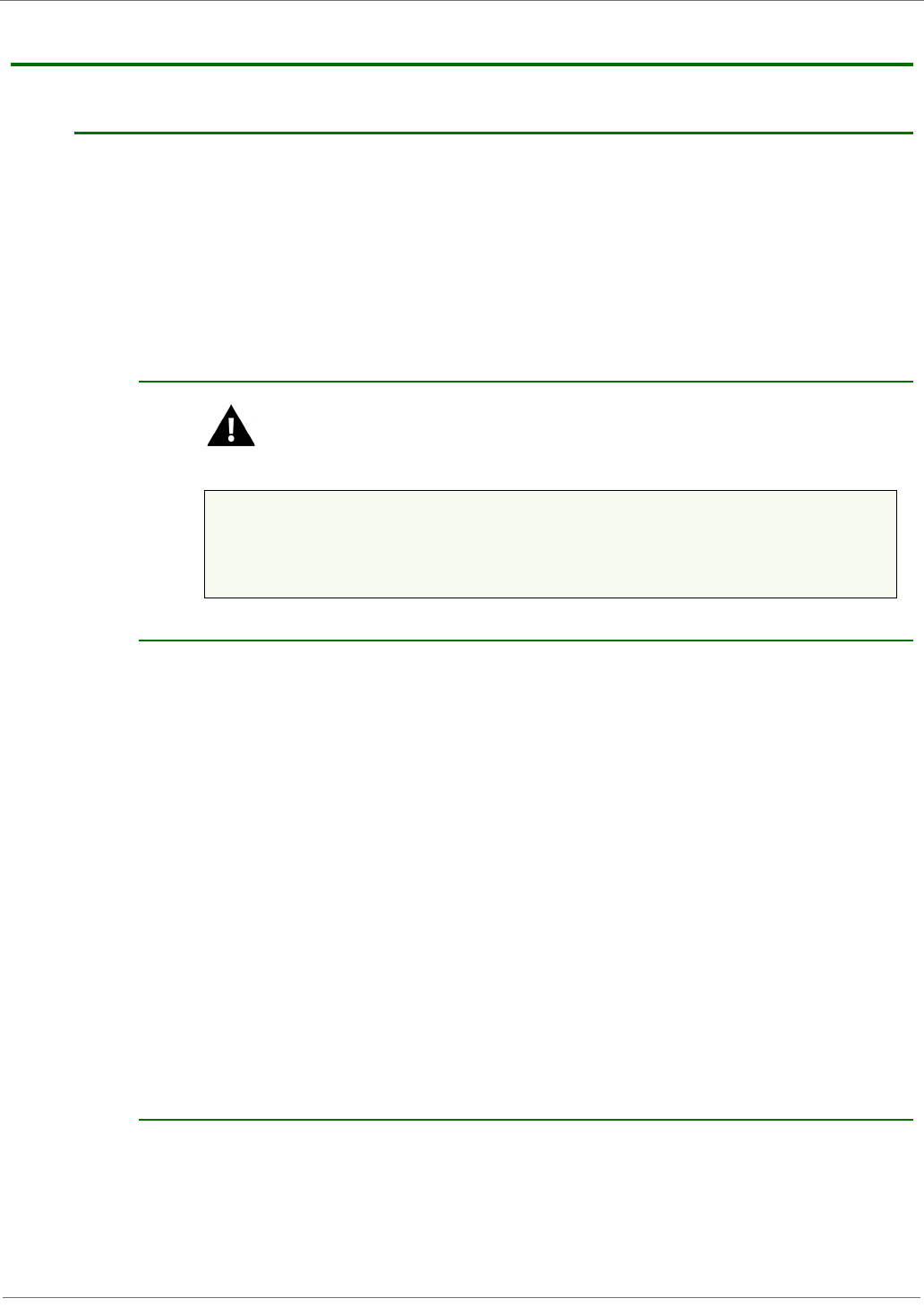
XBee‐PRO™XSCOEMRFModules
©2008DigiInternational,Inc. 33
PreliminaryDraft
AppendixA:AgencyCertifications
FCC (United States) Certification
The XBee-PRO™ XSC OEM RF Module complies with Part 15 of the FCC rules and regulations.
Compliance with the labeling requirements, FCC notices and antenna usage guidelines is required.
In order to operate under Digi’s FCC Certification, OEMs/integrators must comply with the
following regulations:
Labeling Requirements
WARNING: The Original Equipment Manufacturer (OEM) must ensure that FCC labeling
requirements are met. This includes a clearly visible label on the outside of the final
product enclosure that displays the text shown in the figure below.
FigureA‐01. RequiredFCCLabelforOEMproductscontainingtheXBee‐PRO™XSCOEMRFModule
FCC Notices
IMPORTANT: The XBee-PRO™ XSC OEM RF Module has been certified by the FCC for use with
other products without any further certification (as per FCC section 2.1091). Modifications not
expressly approved by Digi could void the user's authority to operate the equipment.
IMPORTANT: OEMs must test final product to comply with unintentional radiators (FCC section
15.107 & 15.109) before declaring compliance of their final product to Part 15 of the FCC Rules.
IMPORTANT: The RF module has been certified for remote and base radio applications. If the
module will be used for portable applications, the device must undergo SAR testing.
This equipment has been tested and found to comply with the limits for a Class B digital device,
pursuant to Part 15 of the FCC Rules. These limits are designed to provide reasonable protection
against harmful interference in a residential installation. This equipment generates, uses and can
radiate radio frequency energy and, if not installed and used in accordance with the instructions,
may cause harmful interference to radio communications. However, there is no guarantee that
interference will not occur in a particular installation.
If this equipment does cause harmful interference to radio or television reception, which can be
determined by turning the equipment off and on, the user is encouraged to try to correct the
interference by one or more of the following measures: Re-orient or relocate the receiving
antenna, Increase the separation between the equipment and receiver, Connect equipment and
receiver to outlets on different circuits, or Consult the dealer or an experienced radio/TV technician
for help.
Limited Modular Approval
This is an RF module approved for Limited Modular use operating as a mobile transmitting device
with respect to section 2.1091 and is limited to OEM installation for Mobile and Fixed applications
only. During final installation, end-users are prohibited from access to any programming
parameters. Professional installation adjustment is required for setting module power and antenna
gain to meet EIRP compliance for high gain antenna(s).
1. The system ntegrator must ensure that the text provided with this device [Figure A-01] is
placed on the outside of the final product and within the final product operation manual.
2. The XBee-PRO™ XSC OEM RF Module may only be used with antennas that have been
tested and approved for use with this module [refer to to Table A-1.
Contains FCC ID: MCQ-XBEEXSC
The enclosed device complies with Part 15 of the FCC Rules. Operation is subject to the following two
conditions: (i.) this device may not cause harmful interference and (ii.) this device must accept any inter-
ference received, including interference that may cause undesired operation.
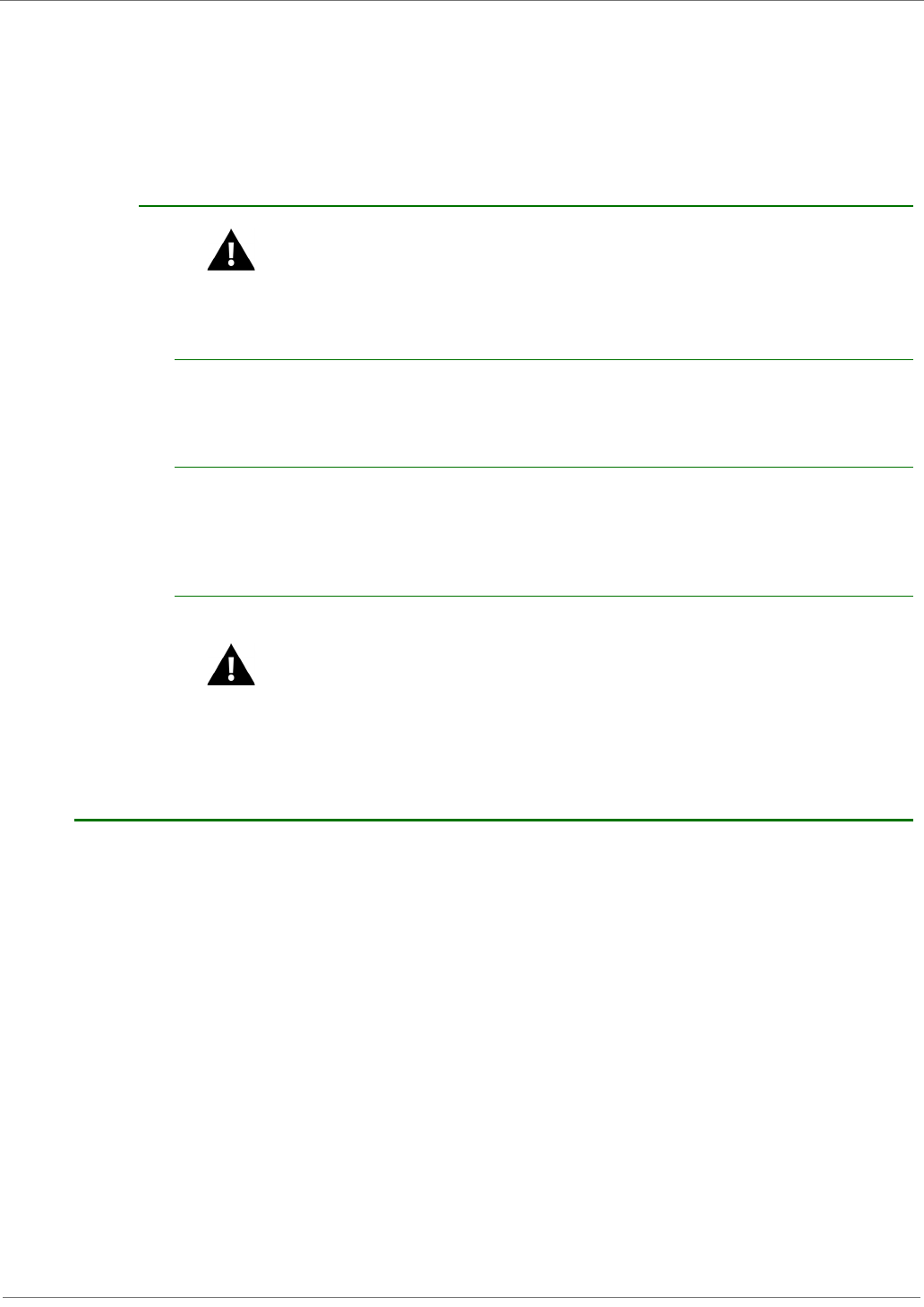
XBee‐PRO™XSCOEMRFModules
©2008DigiInternational,Inc. 34
PreliminaryDraft
Final antenna installation and operating configurations of this transmitter including antenna gain
and cable loss must not exceed the EIRP of the configuration used for calculating MPE. Grantee
(Digi) must coordinate with OEM integrators to ensure the end-users and installers of products
operating with the module are provided with operating instructions to satisfy RF exposure
requirements.
The FCC grant is valid only when the device is sold to OEM integrators. Integrators are instructed
to ensure the end-user has no manual instructions to remove, adjust or install the device.
FCC-approved Antennas
WARNING: This device has been tested with Reverse Polarity SMA connectors with the
antennas listed in the tables of this section. When integrated into OEM products, fixed
antennas require installation preventing end-users from replacing them with non-
approved antennas. Antennas not listed in the tables must be tested to comply with FCC
Section 15.203 (unique antenna connectors) and Section 15.247 (emissions).
Fixed Base Station and Mobile Applications
Digi RF Modules are pre-FCC approved for use in fixed base station and mobile applications. When
the antenna is mounted at least 20cm (8") from nearby persons, the application is considered a
mobile application.
Portable Applications and SAR Testing
When the antenna is mounted closer than 20cm to nearby persons, then the application is
considered "portable" and requires an additional test be performed on the final product. This test
is called Specific Absorption Rate (SAR) testing and measures the emissions from the module and
how they affect the person.
RF Exposure
This statement must be included as a CAUTION statement in OEM product manuals.
WARNING: This equipment is approved only for mobile and base station transmitting
devices. Antenna(s) used for this transmitter must be installed to provide a separation
distance of at least 30 cm from all persons and must not be co-located or operating in
conjunction with any other antenna or transmitter.
NOTE: The separation distance indicated in the above is 30 cm, but any distance greater than or
equal to 23 cm can be used (per MPE evaluation).
IC (Industry Canada) Certification
Labeling requirements for Industry Canada are similar to those of the FCC. A clearly visible label
on the outside of the final product enclosure must display the following text:
Contains Model XBEE-PRO XSC Radio (900 MHz), IC: 1846A-XBEE-PRO XSC
Integrator is responsible for its product to comply with IC ICES-003 & FCC Part 15, Sub. B -
Unintentional Radiators. ICES-003 is the same as FCC Part 15 Sub. B and Industry Canada accepts
FCC test report or CISPR 22 test report for compliance with ICES-003.
Transmitter Antennas
This device has been designed to operate with the antennas listed below, and having a maximum
gain of 15.1 dB. Antennas not included in this list or having a gain greater than 15.1 dB are strictly
prohibited for use with this device. The required antenna impedance is 50 ohms.
Operation is subject to the following two conditions: (1) this device may not cause interference,
and (2) this device must accept any interference, including interference that may cause undesired
operation of the device.
To reduce potential radio interference to other users, the antenna type and its gain should be so
chosen that the equivalent isotropically radiated power (e.i.r.p.) is not more than that permitted
for successful communication

XBee‐PRO™XSCOEMRFModules
©2008DigiInternational,Inc. 35
PreliminaryDraft
Antenna Options (1-watt transmit power output or lower): 900 MHz Antenna Listings
Table A-01. Antennas approved for use with the XBee-PRO XSC OEM RF Module
Part Number Type Connector Gain Application
Omni-directional antennas
A09-F0 Fiberglass Base RPN 0 dBi Fixed
A09-F1 Fiberglass Base RPN 1.0 dBi Fixed
A09-F2 Fiberglass Base RPN 2.1 dBi Fixed
A09-F3 Fiberglass Base RPN 3.1 dBi Fixed
A09-F4 Fiberglass Base RPN 4.1 dBi Fixed
A09-F5 Fiberglass Base RPN 5.1 dBi Fixed
A09-F6 Fiberglass Base RPN 6.1 dBi Fixed
A09-F7 Fiberglass Base RPN 7.1 dBi Fixed
A09-F8 Fiberglass Base RPN 8.1 dBi Fixed
A09-F9 Base Station RPSMAF 9.2dBi Fixed
A09-W7 Wire Base Station RPN 7.1 dBi Fixed
A09-F0 Fiberglass Base RPSMA 0 dBi Fixed
A09-F1 Fiberglass Base RPSMA 1.0 dBi Fixed
A09-F2 Fiberglass Base RPSMA 2.1 dBi Fixed
A09-F3 Fiberglass Base RPSMA 3.1 dBi Fixed
A09-F4 Fiberglass Base RPSMA 4.1 dBi Fixed
A09-F5 Fiberglass Base RPSMA 5.1 dBi Fixed
A09-F6 Fiberglass Base RPSMA 6.1 dBi Fixed
A09-F7 Fiberglass Base RPSMA 7.1 dBi Fixed
A09-F8 Fiberglass Base RPSMA 8.1 dBi Fixed
A09-M7 Base Station RPSMAF 7.2dBi Fixed
A09-W7SM Wire Base Station RPSMA 7.1 dBi Fixed
A09-F0TM Fiberglass Base RPTNC 0 dBi Fixed
A09-F1TM Fiberglass Base RPTNC 1.0 dBi Fixed
A09-F2TM Fiberglass Base RPTNC 2.1 dBi Fixed
A09-F3TM Fiberglass Base RPTNC 3.1 dBi Fixed
A09-F4TM Fiberglass Base RPTNC 4.1 dBi Fixed
A09-F5TM Fiberglass Base RPTNC 5.1 dBi Fixed
A09-F6TM Fiberglass Base RPTNC 6.1 dBi Fixed
A09-F7TM Fiberglass Base RPTNC 7.1 dBi Fixed
A09-F8TM Fiberglass Base RPTNC 8.1 dBi Fixed
A09-W7TM Wire Base Station RPTNC 7.1 dBi Fixed
A09-HSM-7 Straight half-wave RPSMA 3.0 dBi Fixed / Mobile
A09-HASM-675 Articulated half- RPSMA 2.1 dBi Fixed / Mobile
A09-HABMM-P6I Articulated half- MMCX 2.1 dBi Fixed / Mobile
A09-HABMM-6-P6I Articulated half- MMCX 2.1 dBi Fixed / Mobile
A09-HBMM-P6I Straight half-wave MMCX 2.1 dBi Fixed / Mobile
A09-HRSM Right angle half- RPSMA 2.1 dBi Fixed
A09-HASM-7 Articulated half- RPSMA 2.1 dBi Fixed
A09-HG Glass mounted RPSMA 2.1 dBi Fixed
A09-HATM Articulated half- RPTNC 2.1 dBi Fixed
A09-H Half-wave dipole RPSMA 2.1 dBi Fixed
A09-HBMMP6I 1/2 wave antenna MMCX 2.1dBi Mobile

XBee‐PRO™XSCOEMRFModules
©2008DigiInternational,Inc. 36
PreliminaryDraft
A09-QBMMP6I 1/4 wave antenna MMCX 1.9 dBi Mobile
A09-QI 1/4 wave integrated
wire antenna Integrated 1.9 dBi Mobile
29000187 Helical Integrated -2.0 dBi Fixed/Mobile
A09-QW Quarter-wave wire Permanent 1.9 dBi Fixed / Mobile
A09-QRAMM 3 “ Quarter-wave MMCX 2.1 dBi Fixed / Mobile
A09-QSM-3 Quarter-wave RPSMA 1.9 dBi Fixed / Mobile
A09-QSM-3H Heavy duty quarter- RPSMA 1.9 dBi Fixed / Mobile
A09-QBMM-P6I Quarter-wave w/ 6” MMCX 1.9 dBi Fixed / Mobile
A09-QHRN Miniature Helical Permanent -1 dBi Fixed / Mobile
A09-QHSN Miniature Helical Permanent -1 dBi Fixed / Mobile
A09-QHSM-2 2” Straight RPSMA 1.9 dBi Fixed / Mobile
A09-QHRSM-2 2" Right angle RPSMA 1.9 dBi Fixed / Mobile
A09-QHRSM-170 1.7" Right angle RPSMA 1.9 dBi Fixed / Mobile
A09-QRSM-380 3.8" Right angle RPSMA 1.9 dBi Fixed / Mobile
A09-QAPM-520 5.2” Articulated Permanent 1.9 dBi Fixed / Mobile
A09-QSPM-3 3” Straight screw Permanent 1.9 dBi Fixed / Mobile
A09-QAPM-3 3” Articulated screw Permanent 1.9 dBi Fixed / Mobile
A09-QAPM-3H 3” Articulated screw Permanent 1.9 dBi Fixed / Mobile
A09-DPSM-P12F omni directional RPSMA 3.0 dBi Fixed
A09-D3NF-P12F omni directional RPN 3.0 dBi Fixed
A09-D3SM-P12F omni directional w/ RPSMA 3.0 dBi Fixed
A09-D3PNF omni directional RPN 3.0 dBi Fixed
A09-D3TM-P12F omni directional w/ RPTNC 3.0 dBi Fixed
A09-D3PTM omni directional RPTNC 3.0 dBi Fixed
A09-M0SM Mag Mount RPSMA 0 dBi Fixed
A09-M2SM Mag Mount RPSMA 2.1 dBi Fixed
A09-M3SM Mag Mount RPSMA 3.1 dBi Fixed
A09-M5SM Mag Mount RPSMA 5.1 dBi Fixed
A09-M7SM Mag Mount RPSMA 7.1 dBi Fixed
A09-M8SM Mag Mount RPSMA 8.1 dBi Fixed
A09-M0TM Mag Mount RPTNC 0 dBi Fixed
A09-M2TM Mag Mount RPTNC 2.1 dBi Fixed
A09-M3TM Mag Mount RPTNC 3.1 dBi Fixed
A09-M5TM Mag Mount RPTNC 5.1 dBi Fixed
A09-M7TM Mag Mount RPTNC 7.1 dBi Fixed
A09-M8TM Mag Mount RPTNC 8.1 dBi Fixed
Yagi antennas
A09-Y6 2 Element Yagi RPN 6.1 dBi Fixed / Mobile
A09-Y7 3 Element Yagi RPN 7.1 dBi Fixed / Mobile
A09-Y8 4 Element Yagi RPN 8.1 dBi Fixed / Mobile
A09-Y9 4 Element Yagi RPN 9.1 dBi Fixed / Mobile
A09-Y10 5 Element Yagi RPN 10.1 dBi Fixed / Mobile
A09-Y11 6 Element Yagi RPN 11.1 dBi Fixed / Mobile
A09-Y12 7 Element Yagi RPN 12.1 dBi Fixed / Mobile
A09-Y13 9 Element Yagi RPN 13.1 dBi Fixed / Mobile
A09-Y14 10 Element Yagi RPN 14.1 dBi Fixed / Mobile
A09-Y14 12 Element Yagi RPN 14.1 dBi Fixed / Mobile

XBee‐PRO™XSCOEMRFModules
©2008DigiInternational,Inc. 37
PreliminaryDraft
A09-Y15 13 Element Yagi RPN 15.1 dBi Fixed / Mobile
A09-Y15 15 Element Yagi RPN 15.1 dBi Fixed / Mobile
A09-Y6TM 2 Element Yagi RPTNC 6.1 dBi Fixed / Mobile
A09-Y7TM 3 Element Yagi RPTNC 7.1 dBi Fixed / Mobile
A09-Y8TM 4 Element Yagi RPTNC 8.1 dBi Fixed / Mobile
A09-Y9TM 4 Element Yagi RPTNC 9.1 dBi Fixed / Mobile
A09-Y10TM 5 Element Yagi RPTNC 10.1 dBi Fixed / Mobile
A09-Y11TM 6 Element Yagi RPTNC 11.1 dBi Fixed / Mobile
A09-Y12TM 7 Element Yagi RPTNC 12.1 dBi Fixed / Mobile
A09-Y13TM 9 Element Yagi RPTNC 13.1 dBi Fixed / Mobile
A09-Y14TM 10 Element Yagi RPTNC 14.1 dBi Fixed / Mobile
A09-Y14TM 12 Element Yagi RPTNC 14.1 dBi Fixed / Mobile
A09-Y15TM 13 Element Yagi RPTNC 15.1 dBi Fixed / Mobile
A09-Y15TM 15 Element Yagi RPTNC 15.1 dBi Fixed / Mobile
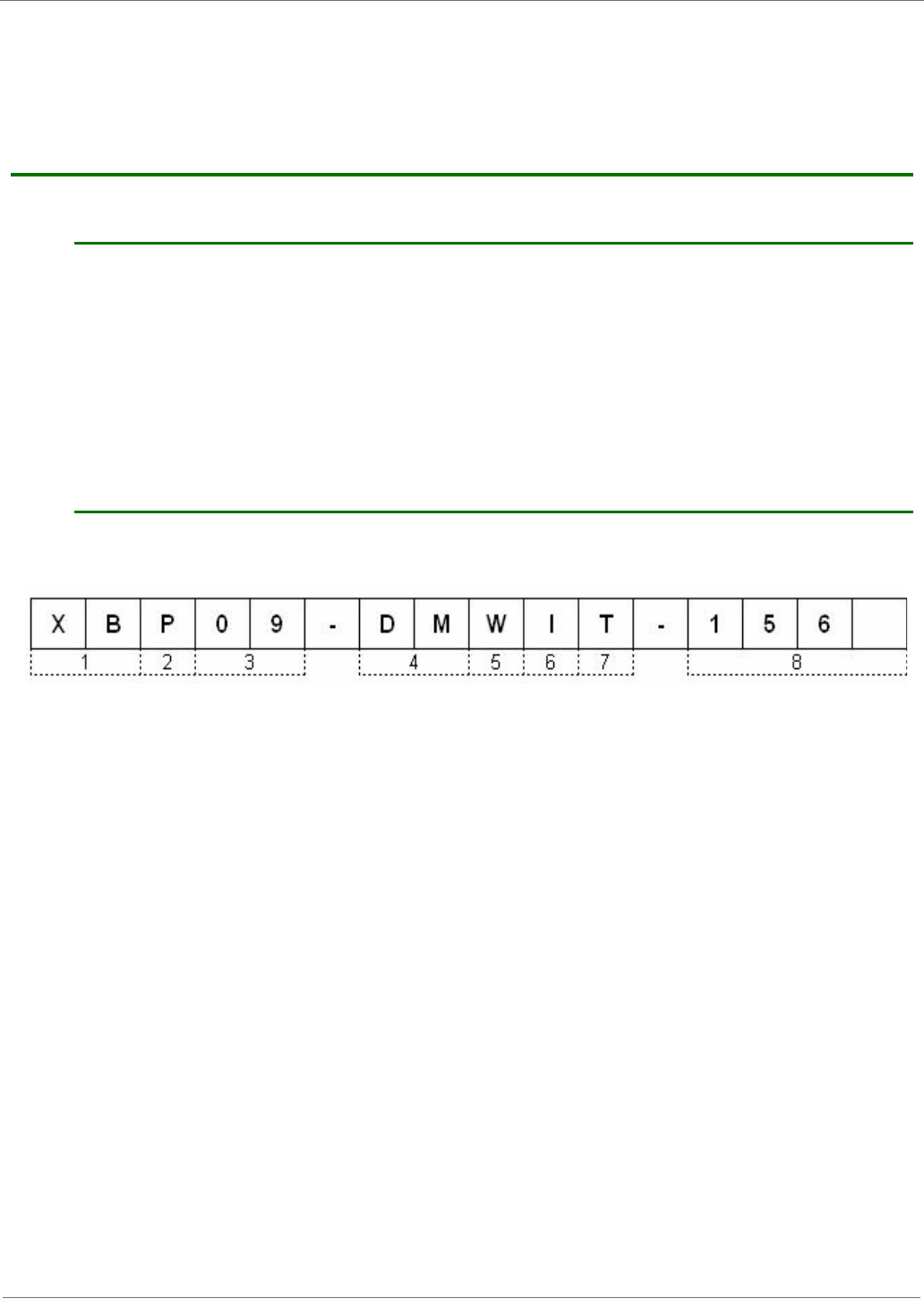
XBee‐PRO™XSCOEMRFModules
©2008DigiInternational,Inc. 38
PreliminaryDraft
AppendixB:AdditionalInformation
5-Year Warranty
WARRANTY PERIOD: Digi warranties hardware Product for a period of five (5) years.
WARRANTY PROCEDURE: Upon return of the hardware Product Digi will, at its option, repair or
replace Product at no additional charge, freight prepaid, except as set forth below. Repair parts
and replacement Product will be furnished on an exchange basis and will be either reconditioned or
new. All replaced Product and parts become the property of Digi. If Digi determines that the
Product is not under warranty, it will, at the Customers option, repair the Product using current
Digi standard rates for parts and labor, and return the Product UPS Ground at no charge in or out
of warranty.
Ordering Information
FigureB‐01. ModulePartNumberMatrix
1Product Family
XB = XBee
2Power / Range
P = PRO
Not used = Regular
3Frequency
09 = 900 MHz
24 = 2.4 GHz
H9 = 915 MHz (Australia)
08 = 868 MHz (Europe)
4Protocol
A = 802.15.4 (Series 1)
B = ZNet 2.5 (Series 2)
DM = DigiMesh
DP = Digi Point to Multipoint

XBee‐PRO™XSCOEMRFModules
©2008DigiInternational,Inc. 39
PreliminaryDraft
XC = XStream Compatible
Z6 = ZigBee 2006
Z7 = ZigBee 2007
WF = WiFi (802.11)
5 Antenna Type
C = Chip
H = Helical
S = SMA
U = U.FL
W = Wire
N = None
6 Temperature Rating
C = Commercial
I = Industrial
T = Tested
7 Mount
T = Through-hole
S = Surface Mount (Not used currently)
Not used for XBee 802.15.4 (Series 1)
8Variation
Baud, Firmware, Customer Specific Settings
When Protocol = DM, DP and XC
001 = 1200 bps
009 = 9600 bps
019 = 19200 bps
156 = 156000 bps
When Protocol = A, B, Z6 and Z7
001 = standard firmware for XBee 802.15.4 (Series 1)
004 = Router, AT for XBee ZNet2.5 (Series 2)
other firmware settings as needed
J at the end = Japan certified version

XBee‐PRO™XSCOEMRFModules
©2008DigiInternational,Inc. 40
PreliminaryDraft
Contact Digi
For the best in wireless data solutions and support, please use the following resources:
Office hours are 8:00 am - 5:00 pm [U.S. Mountain Time]
Technical Support: Phone. (866) 765-9885 toll-free U.S.A. & Canada
(801) 765-9885 Worldwide
Live Chat. www.digi.com
E-Mail. support @digi.com